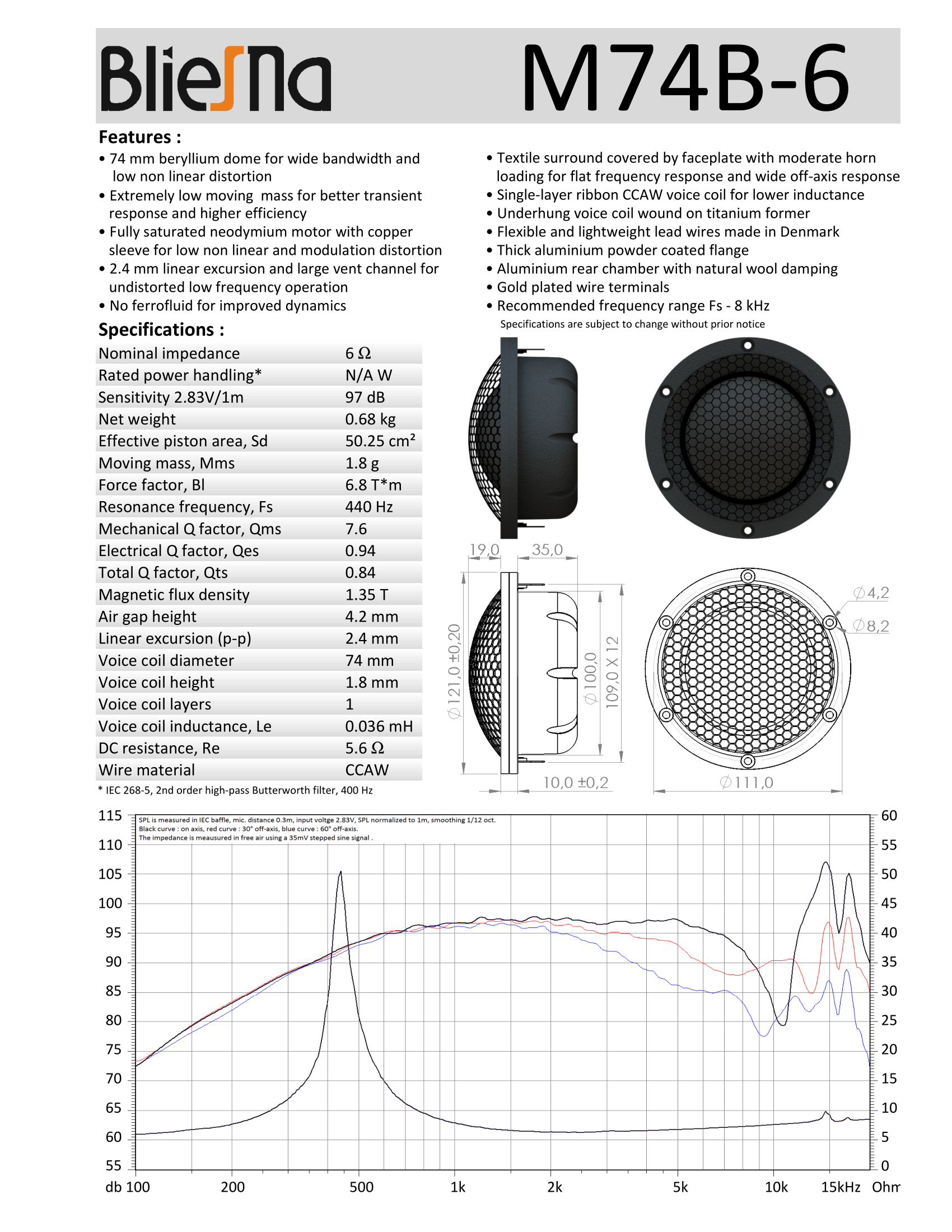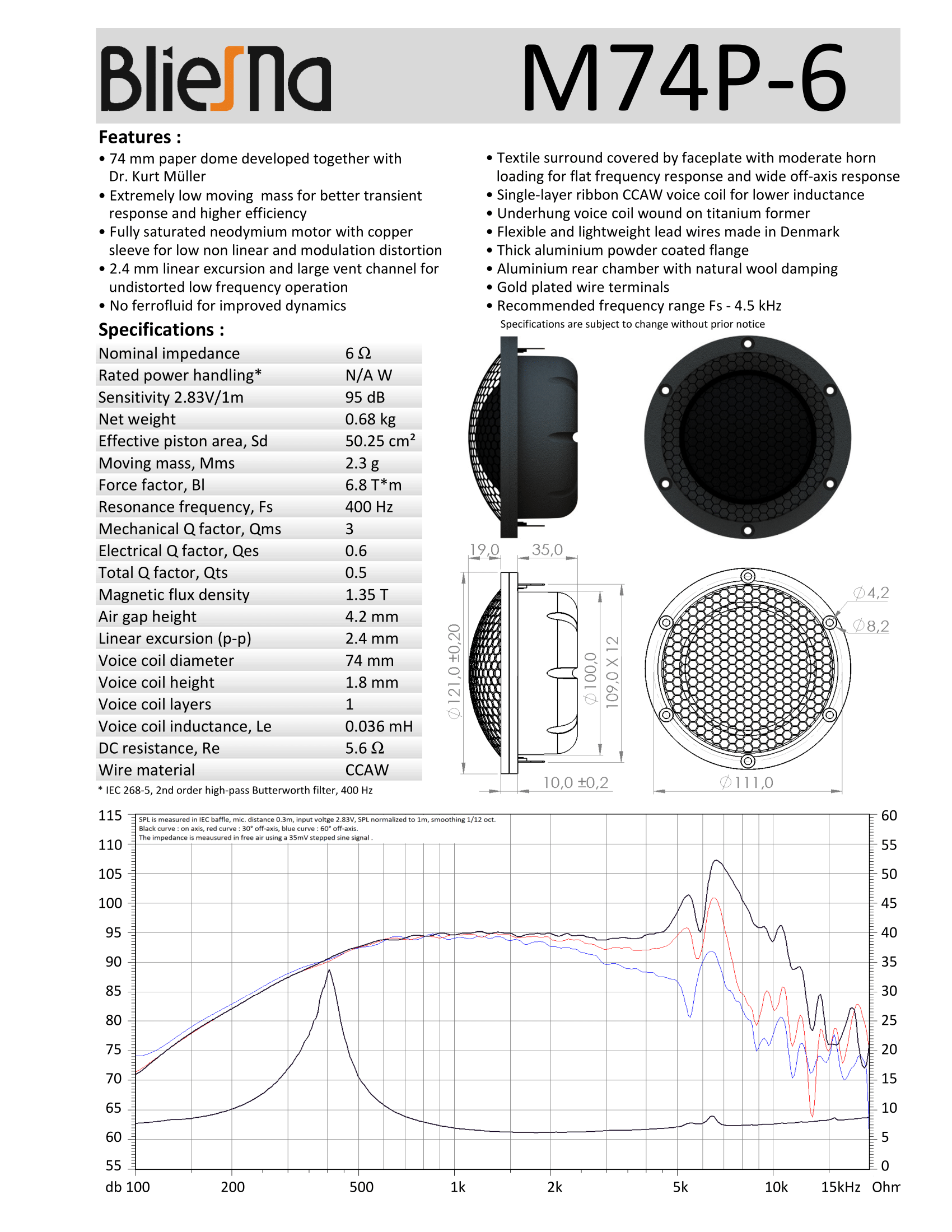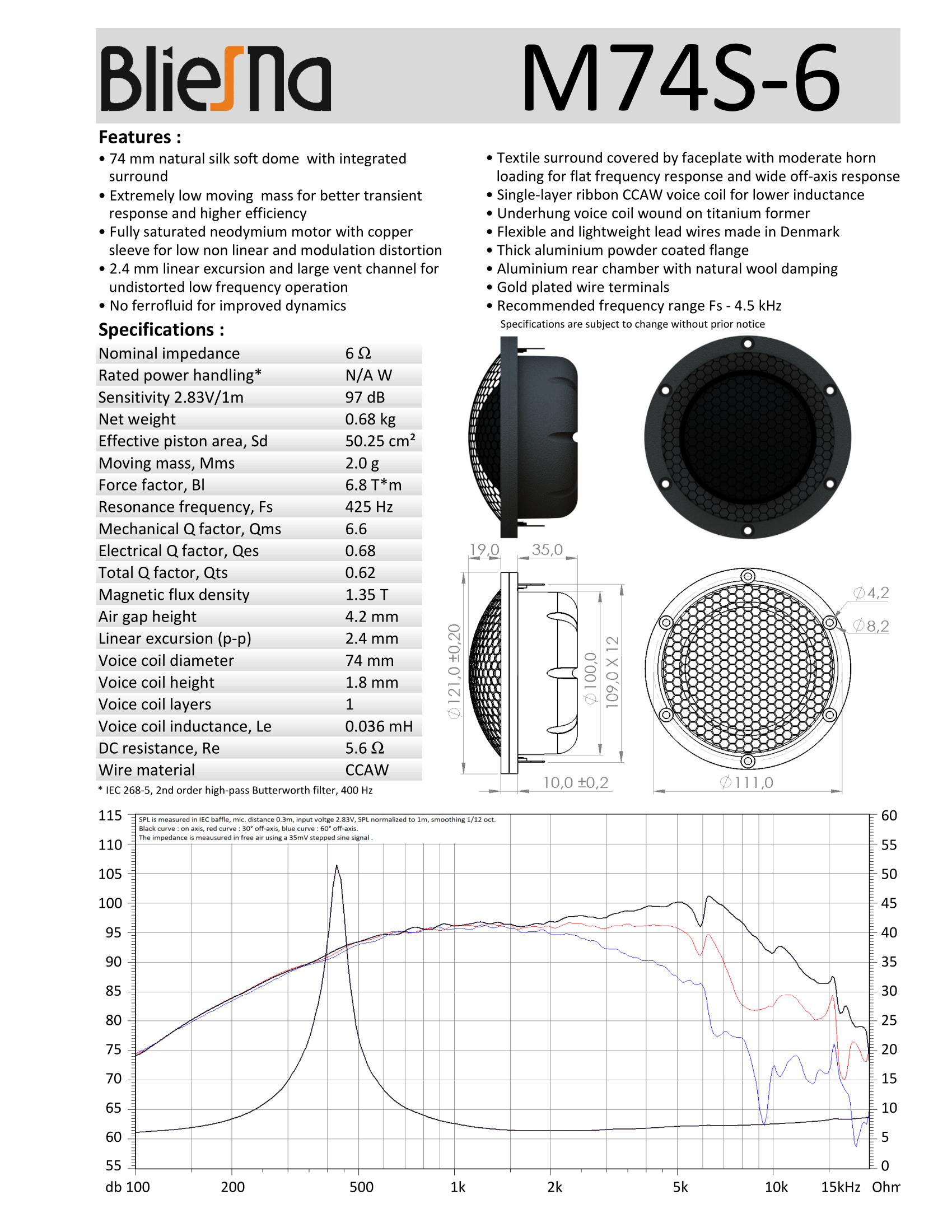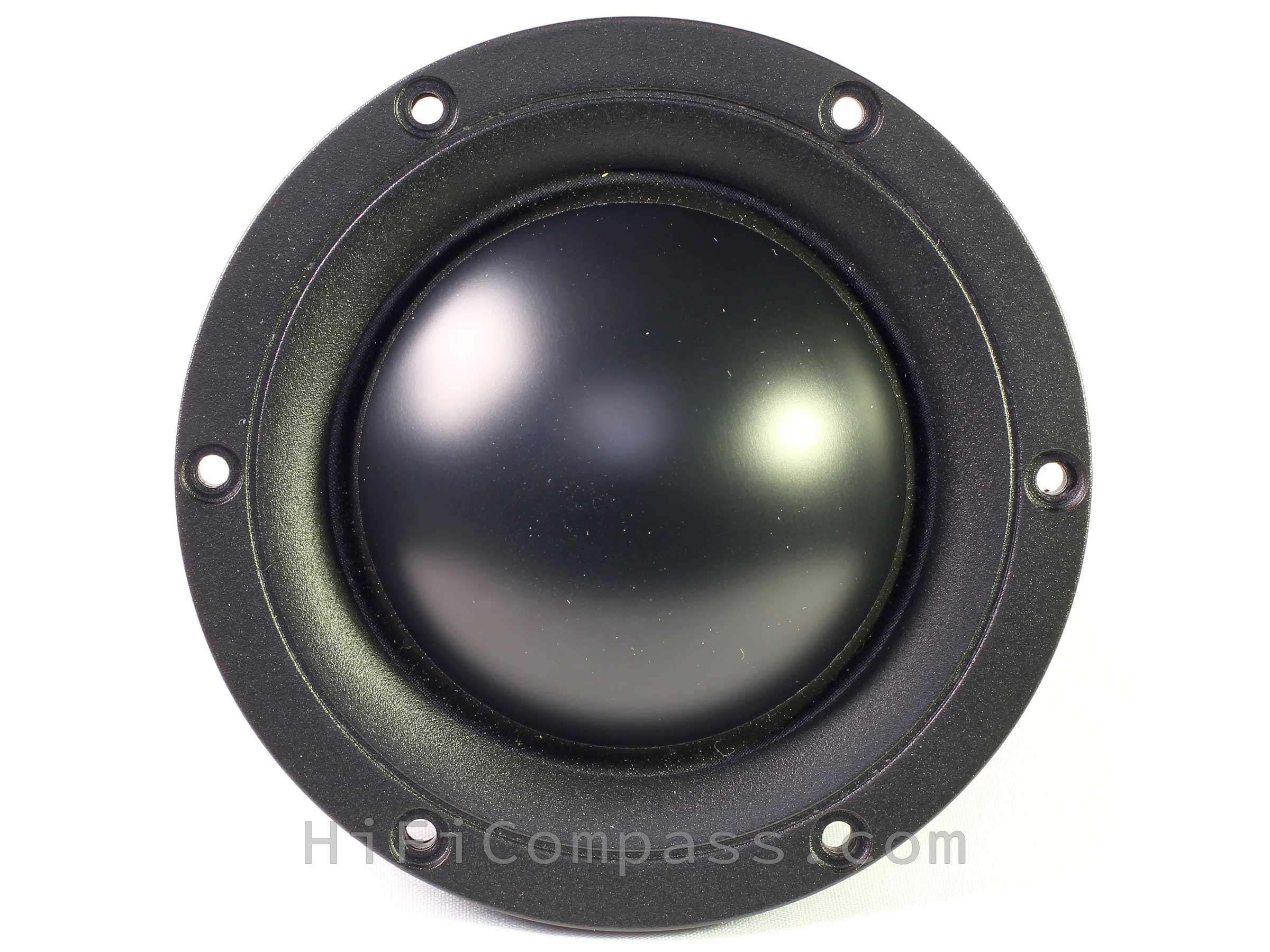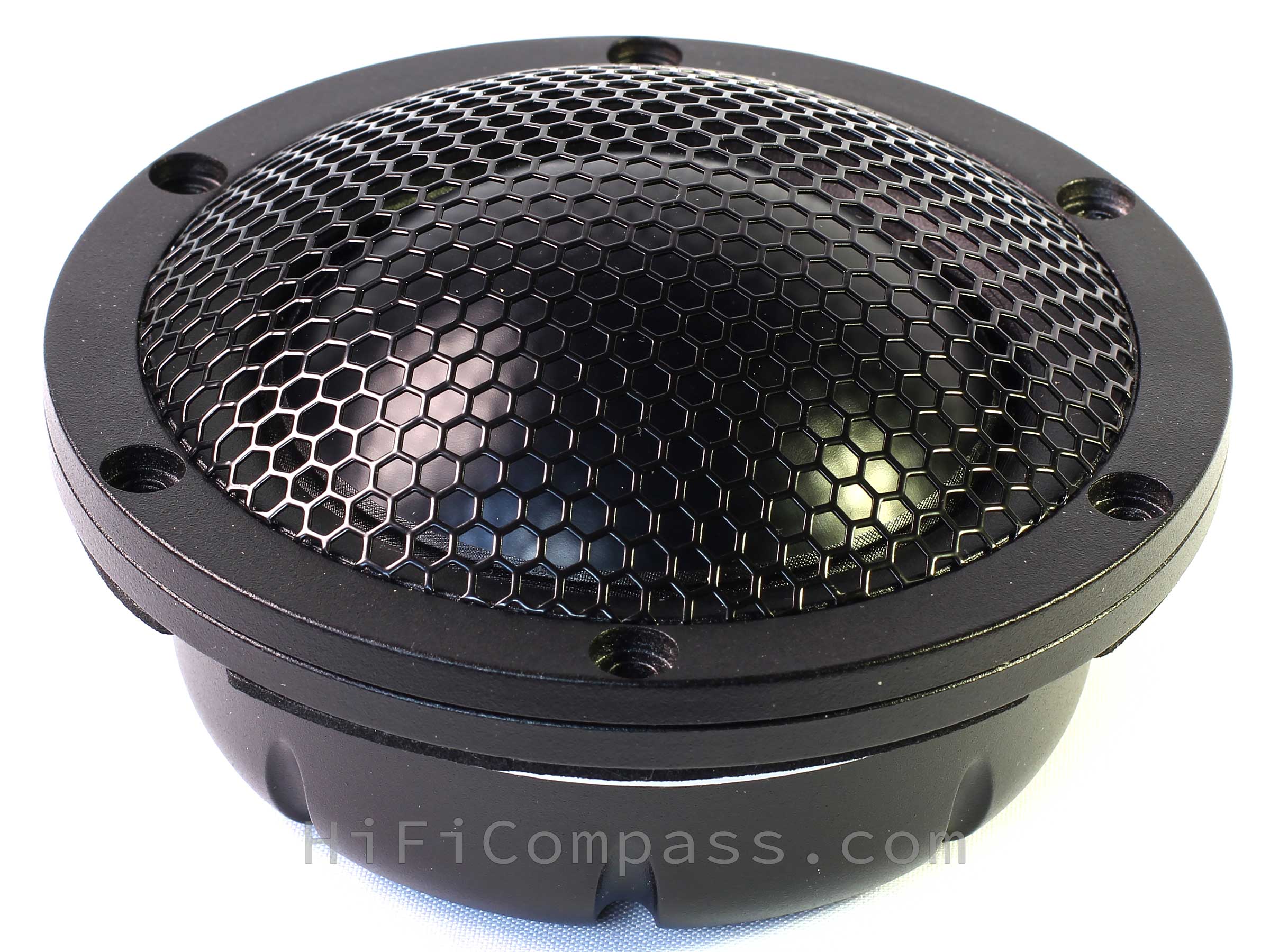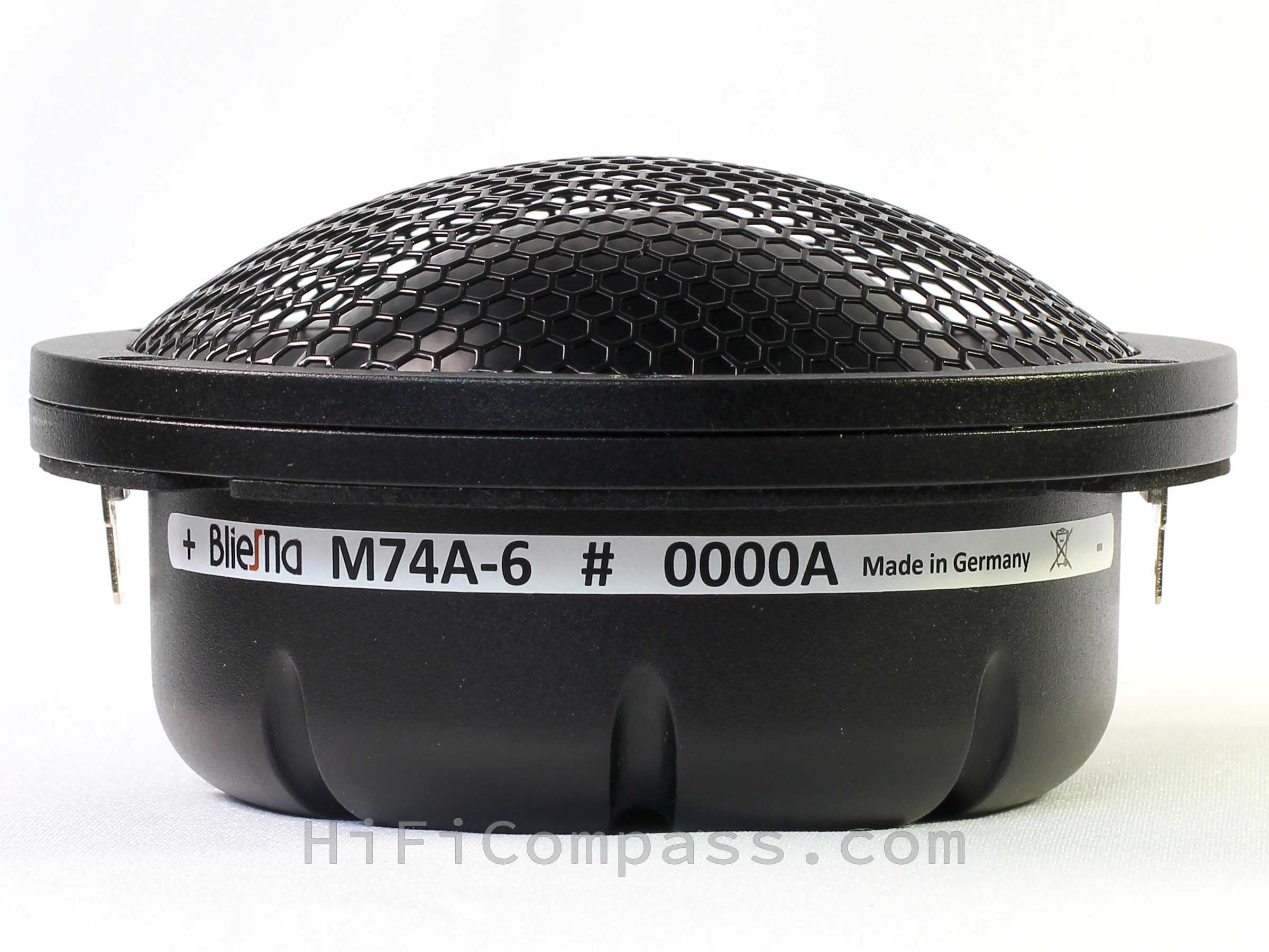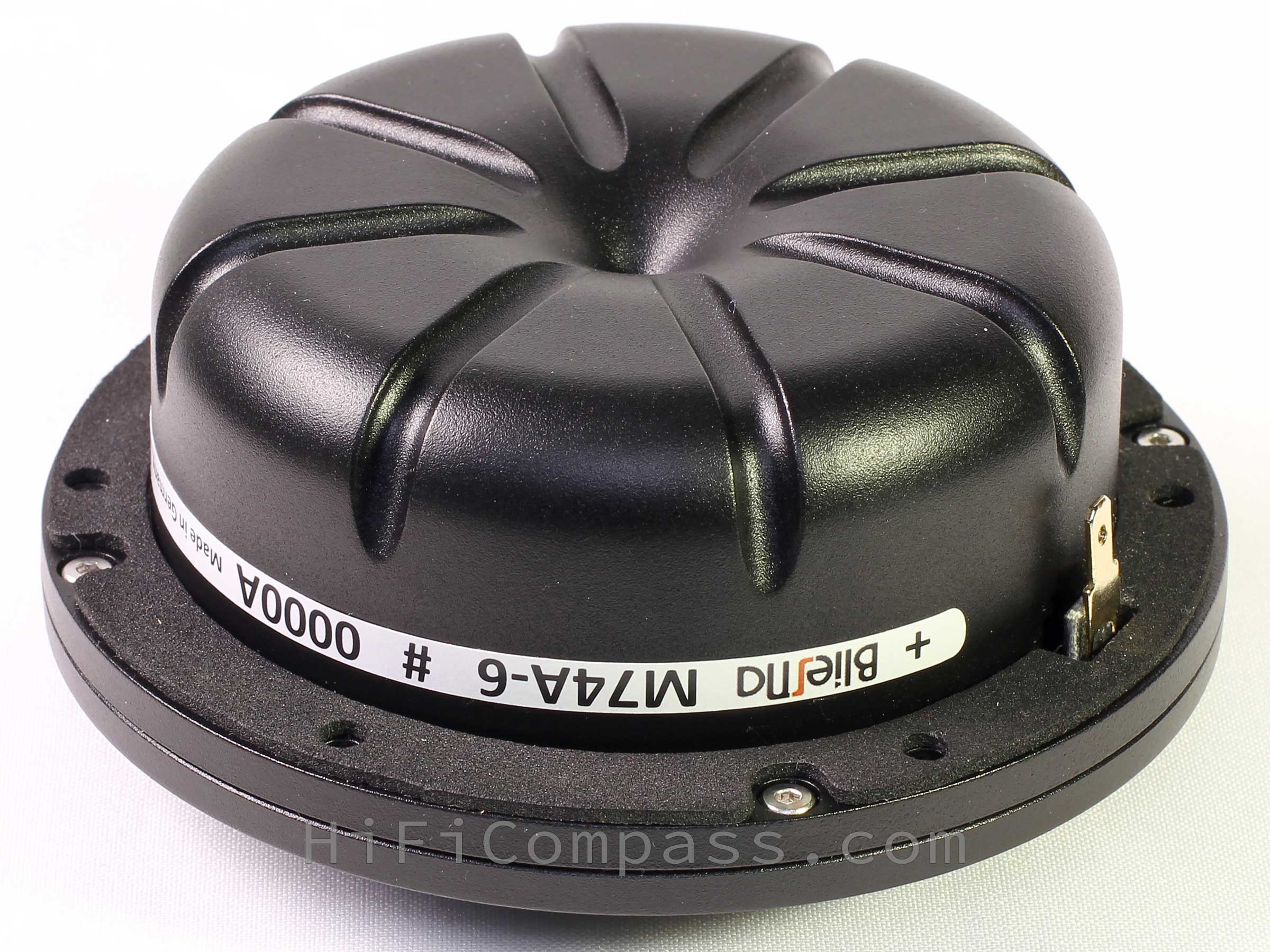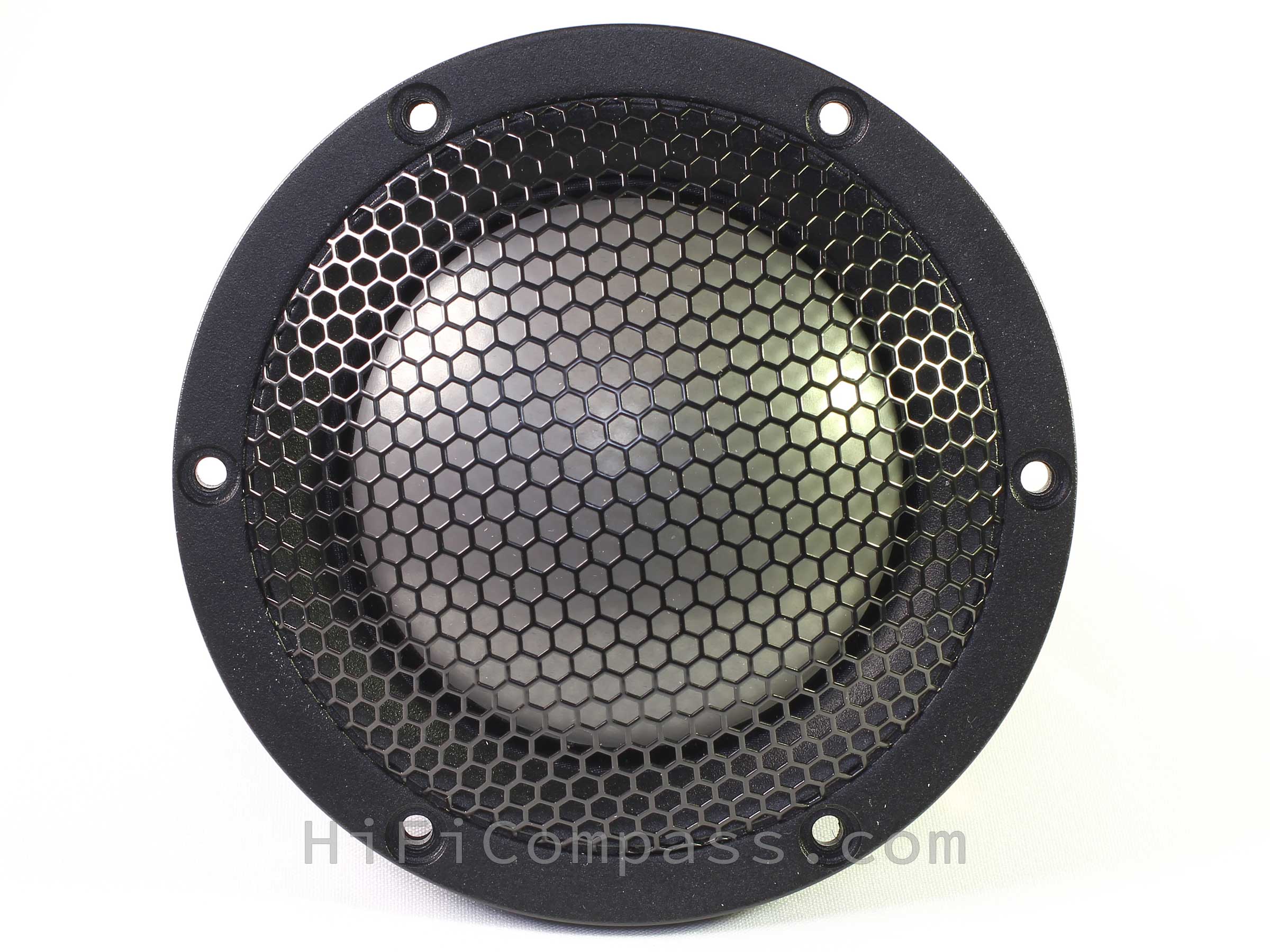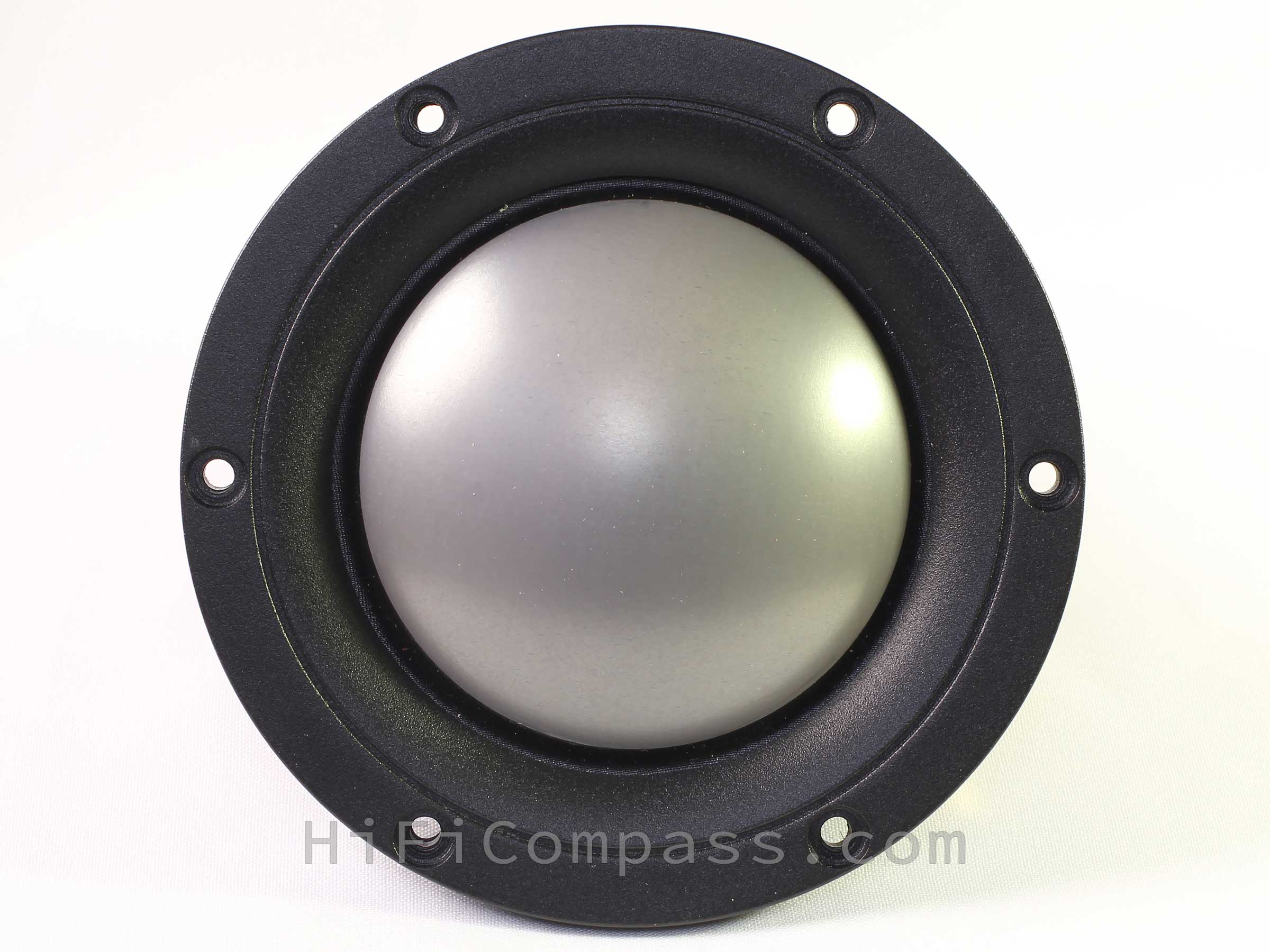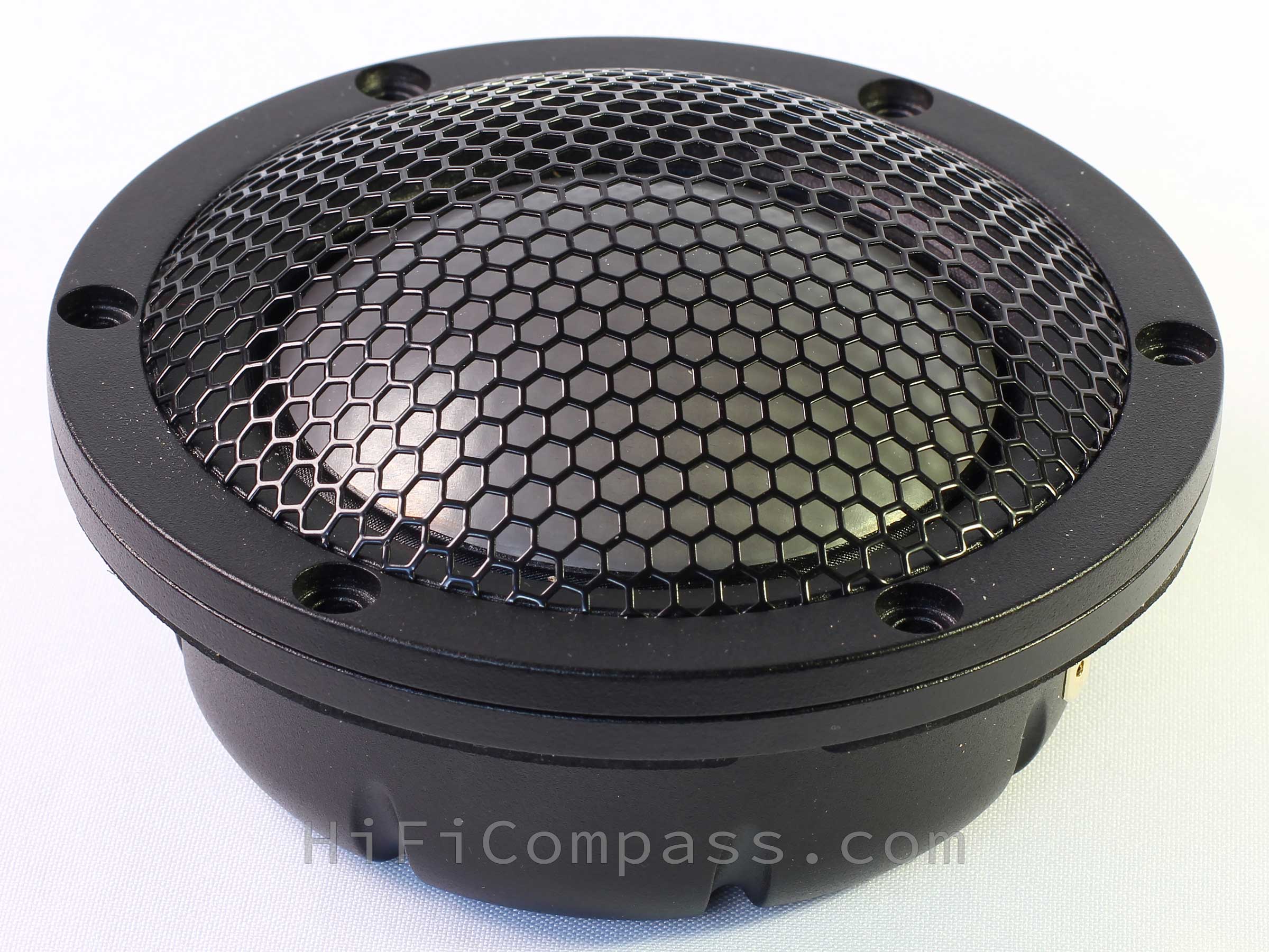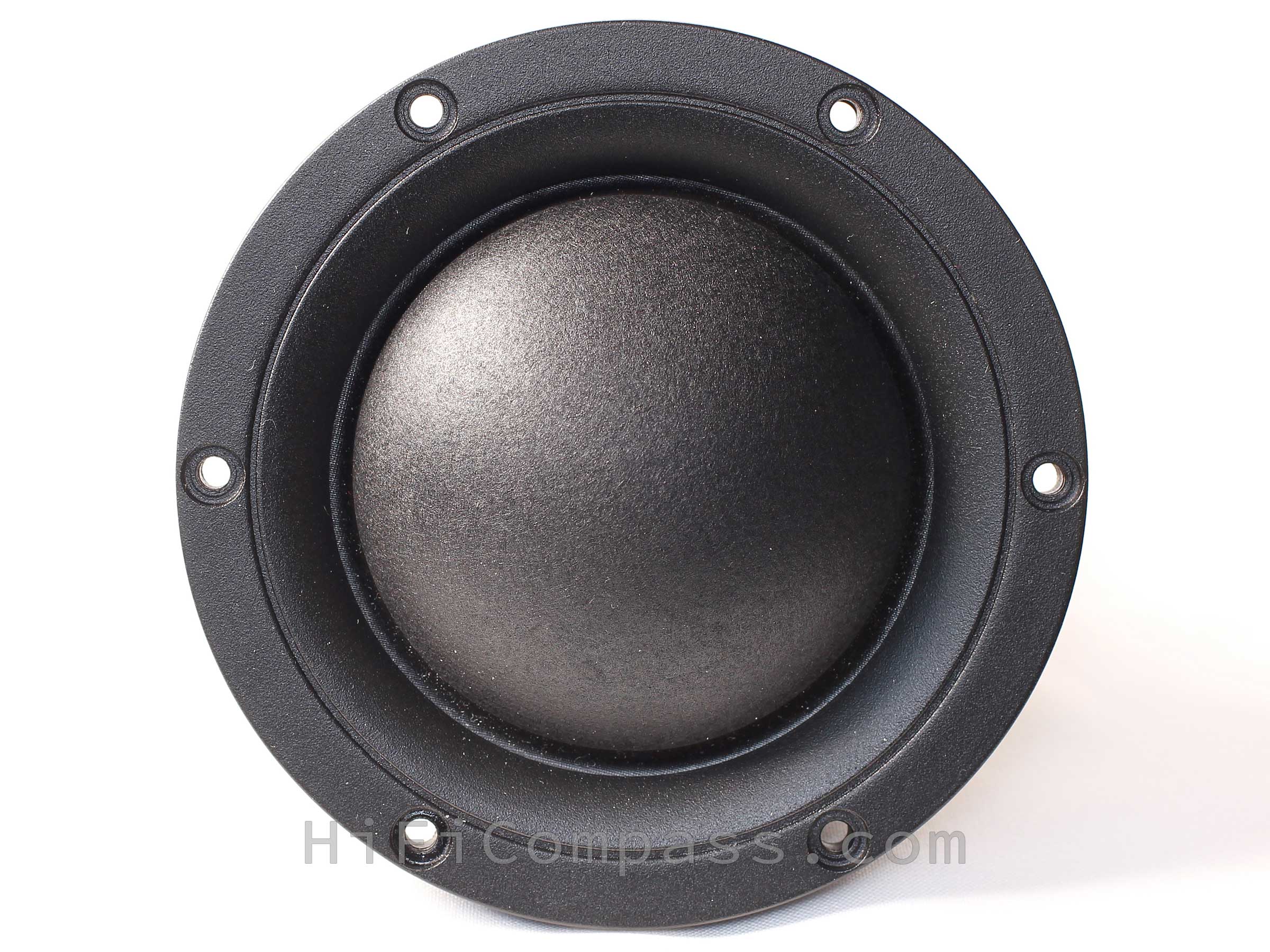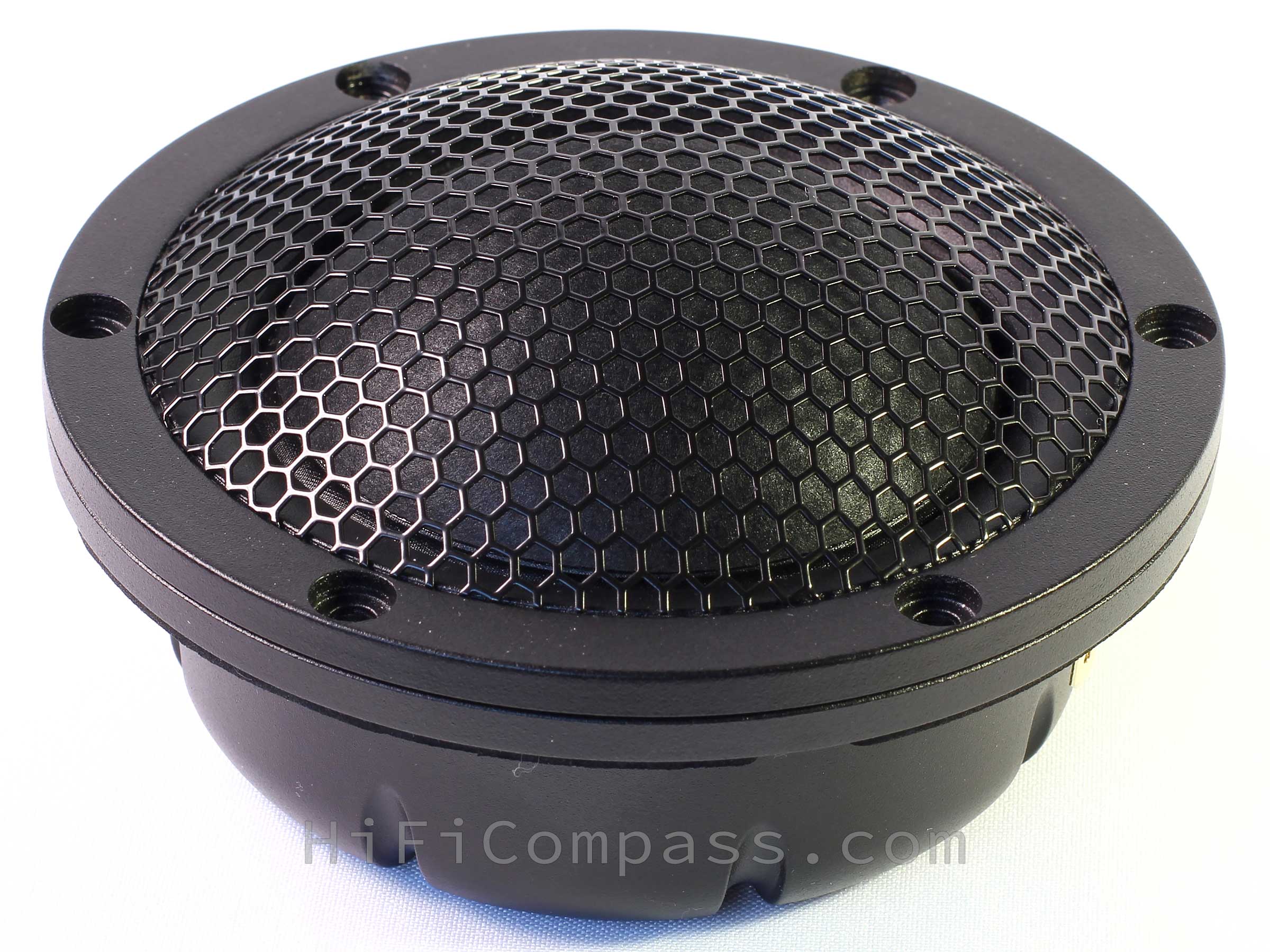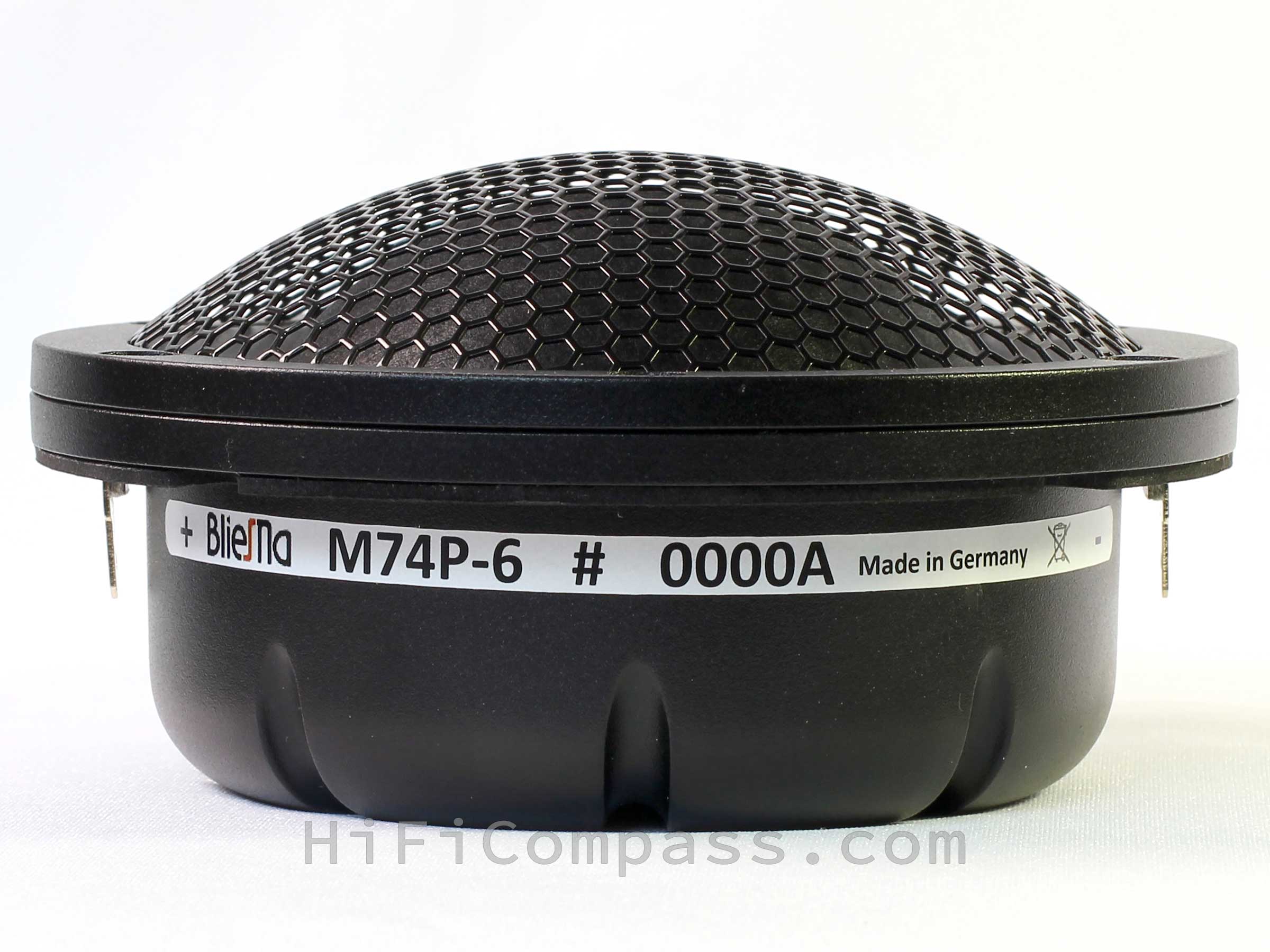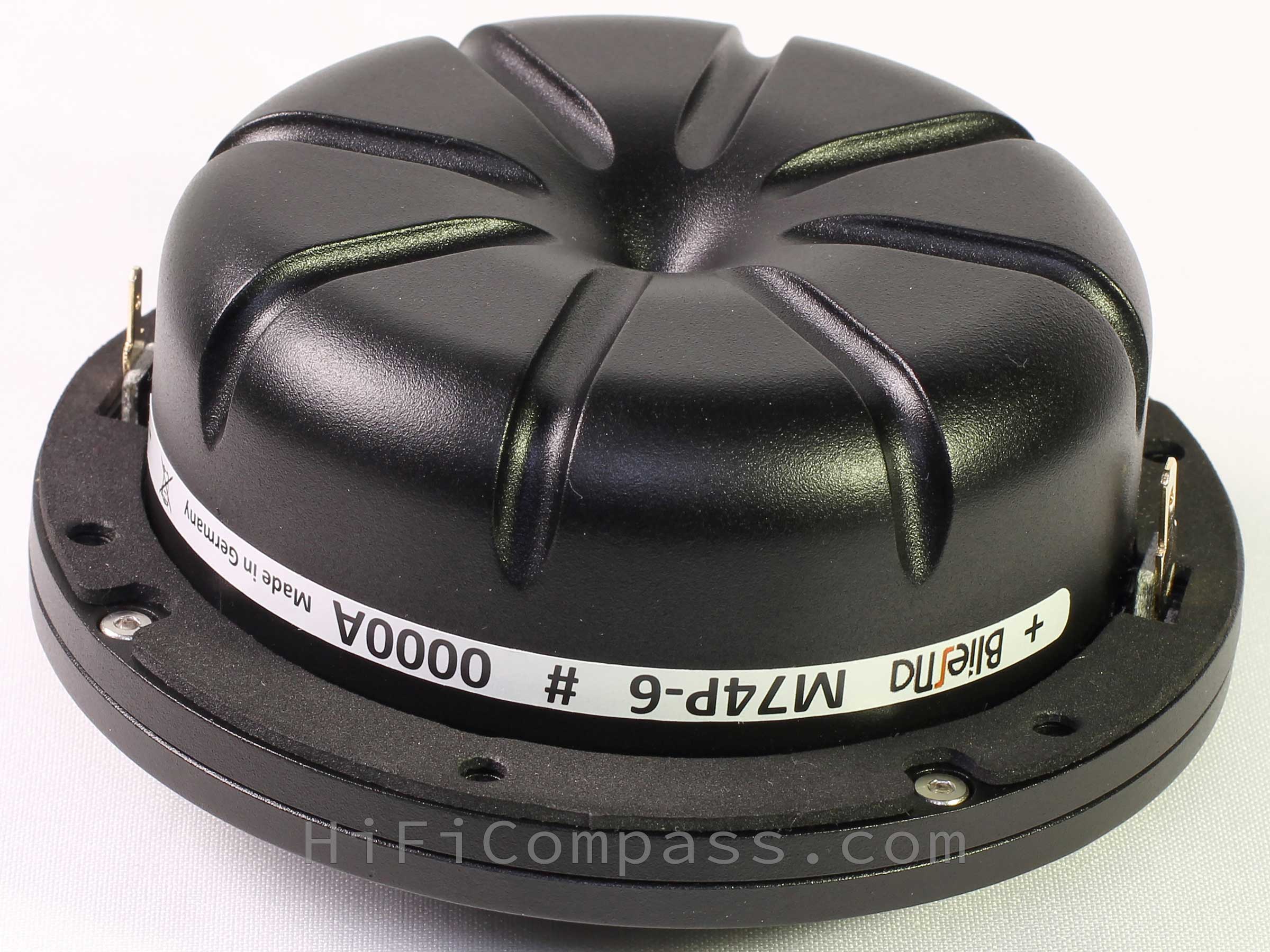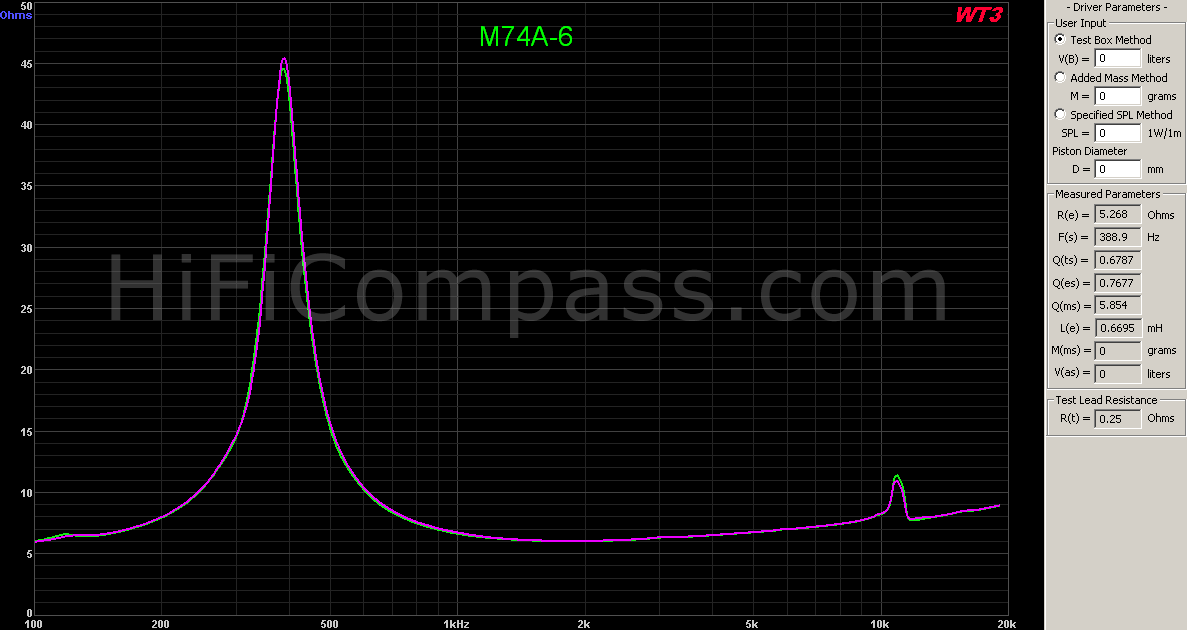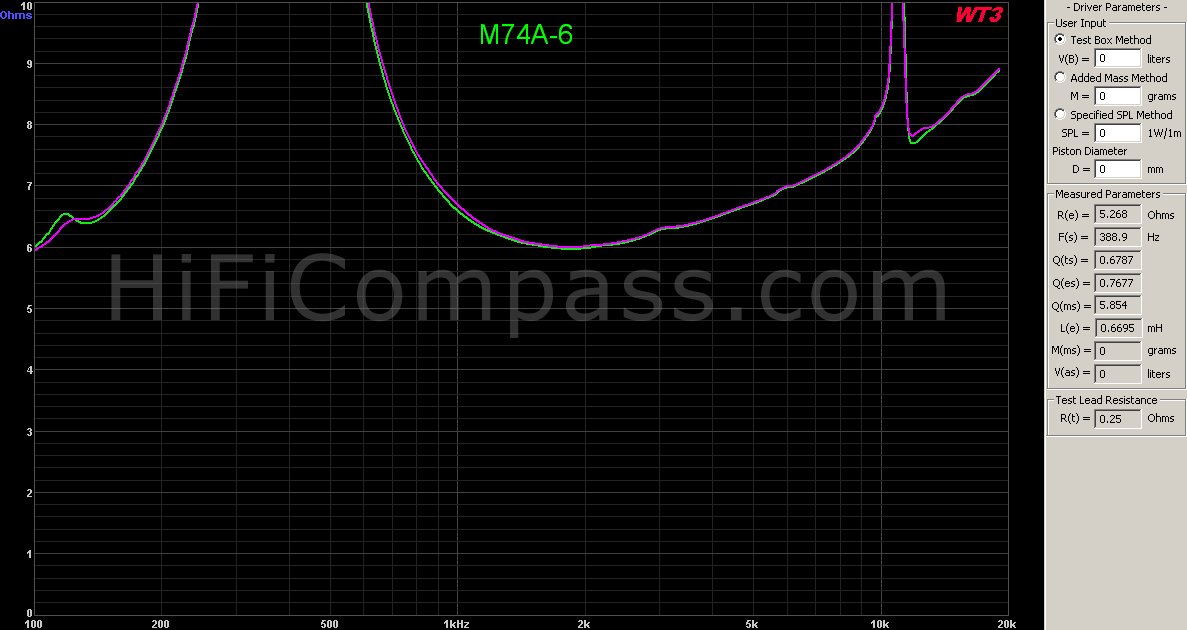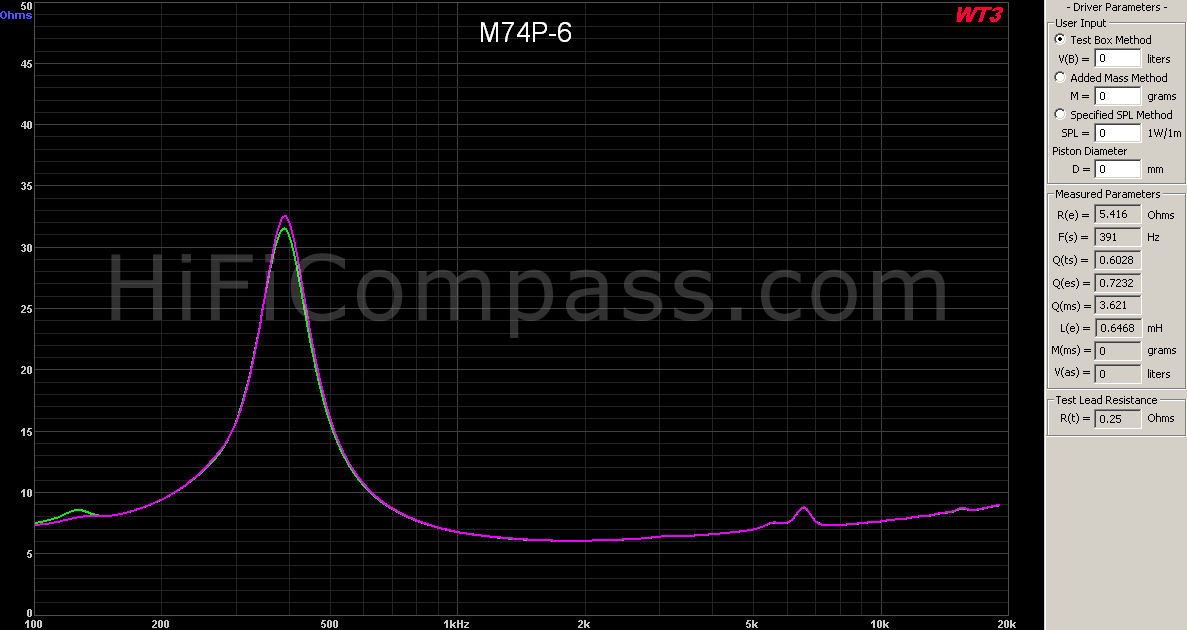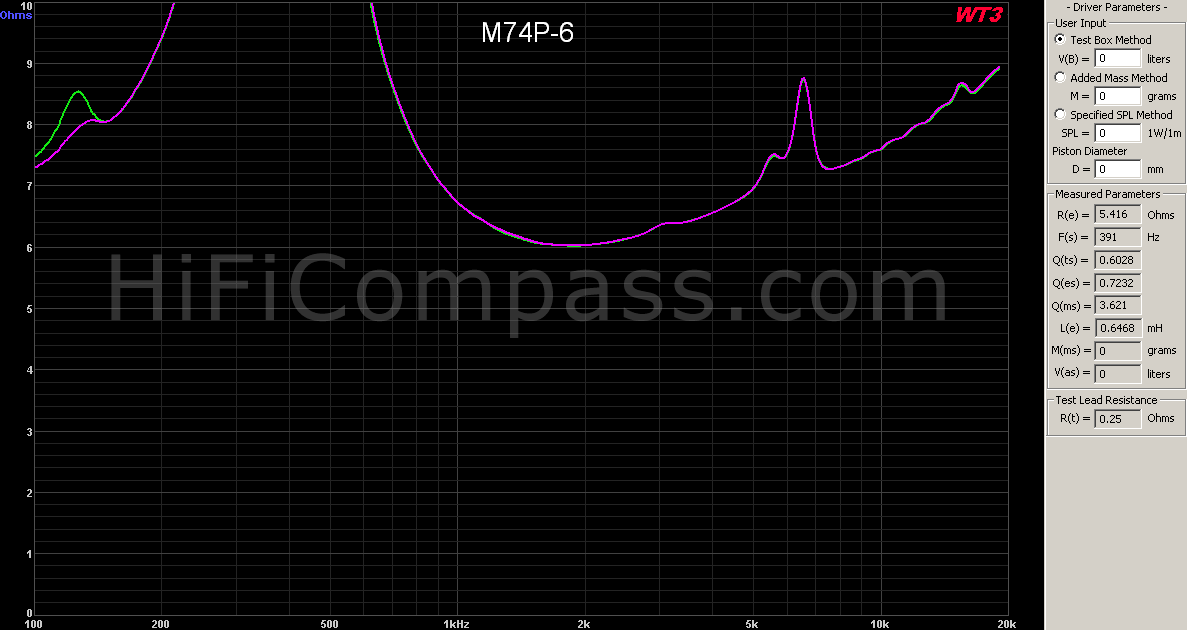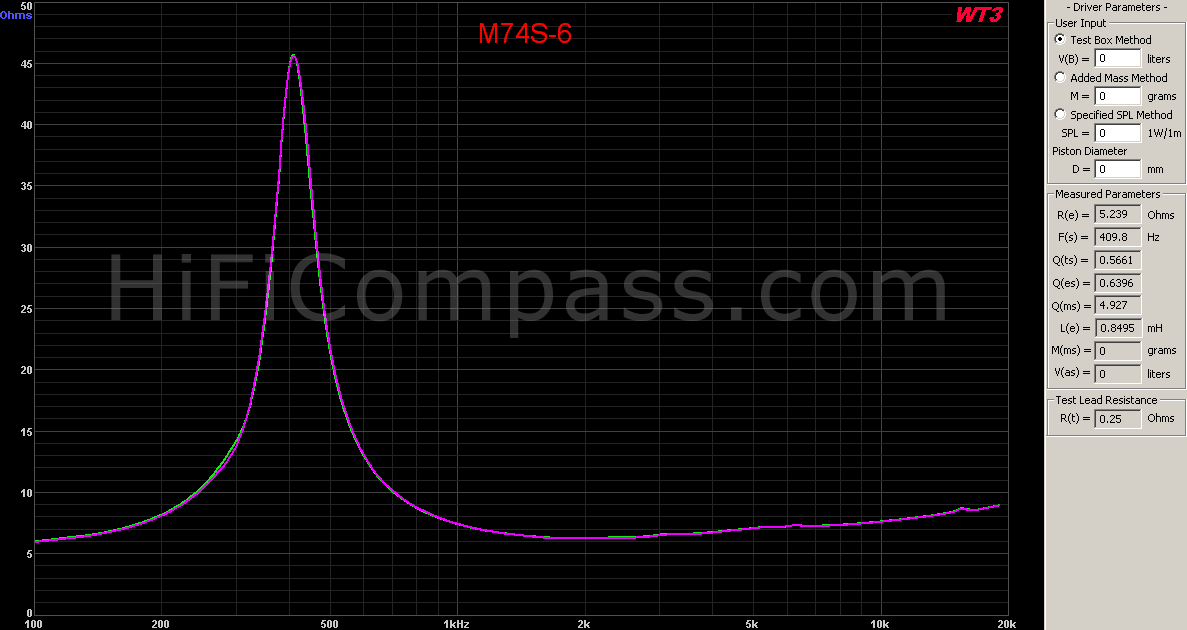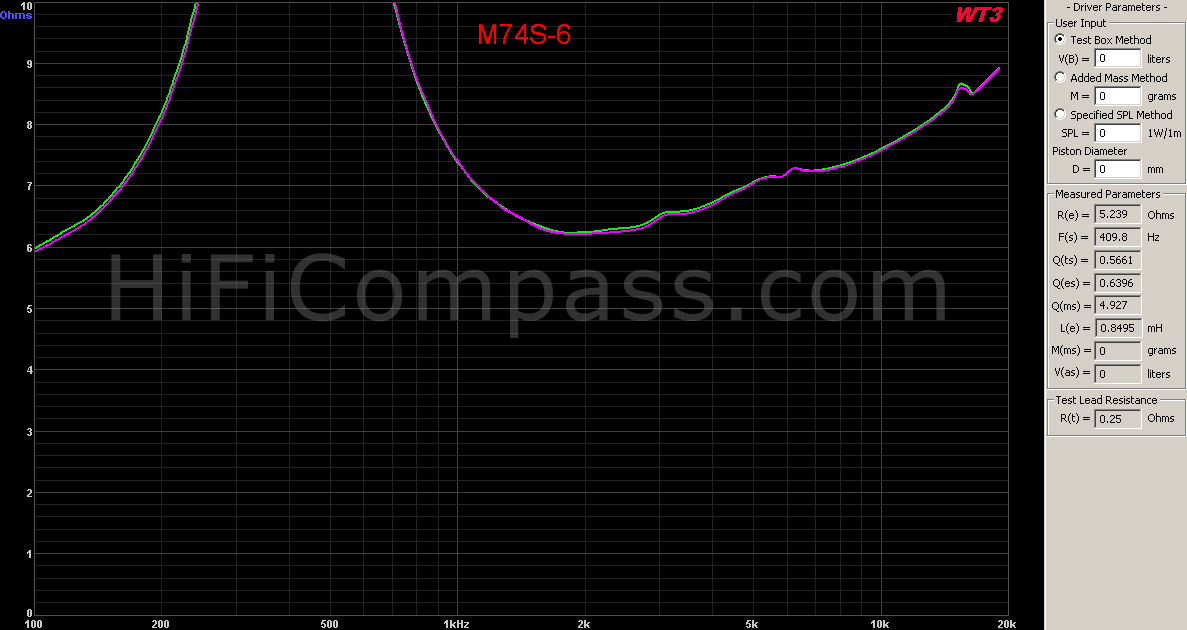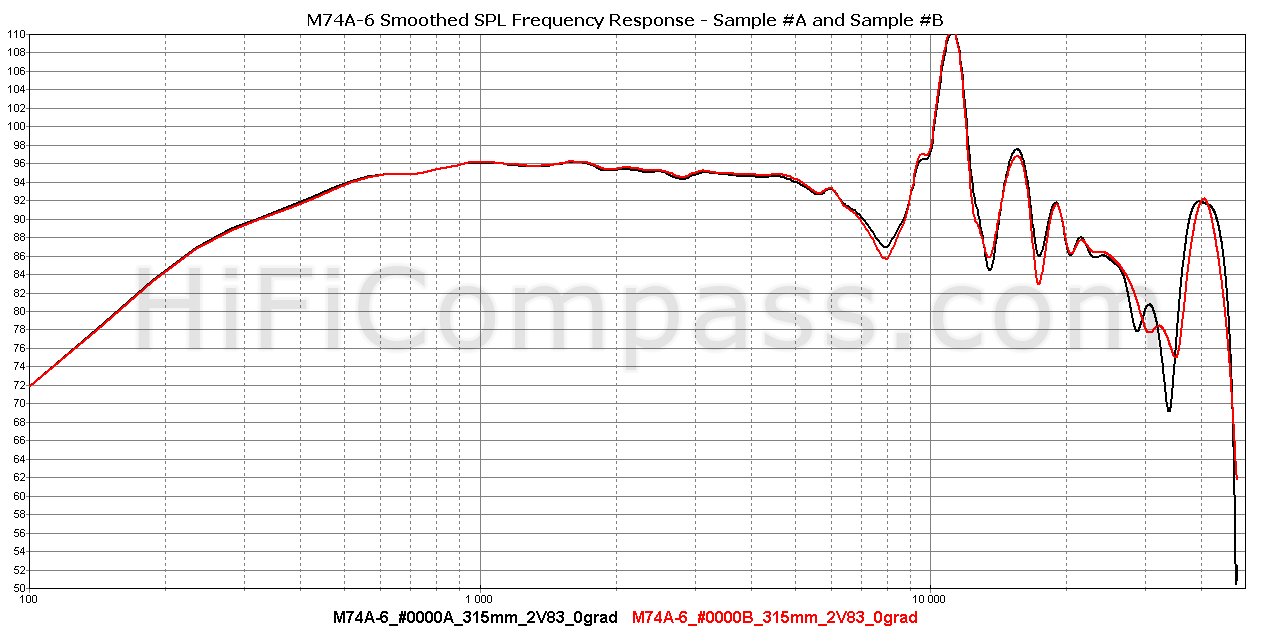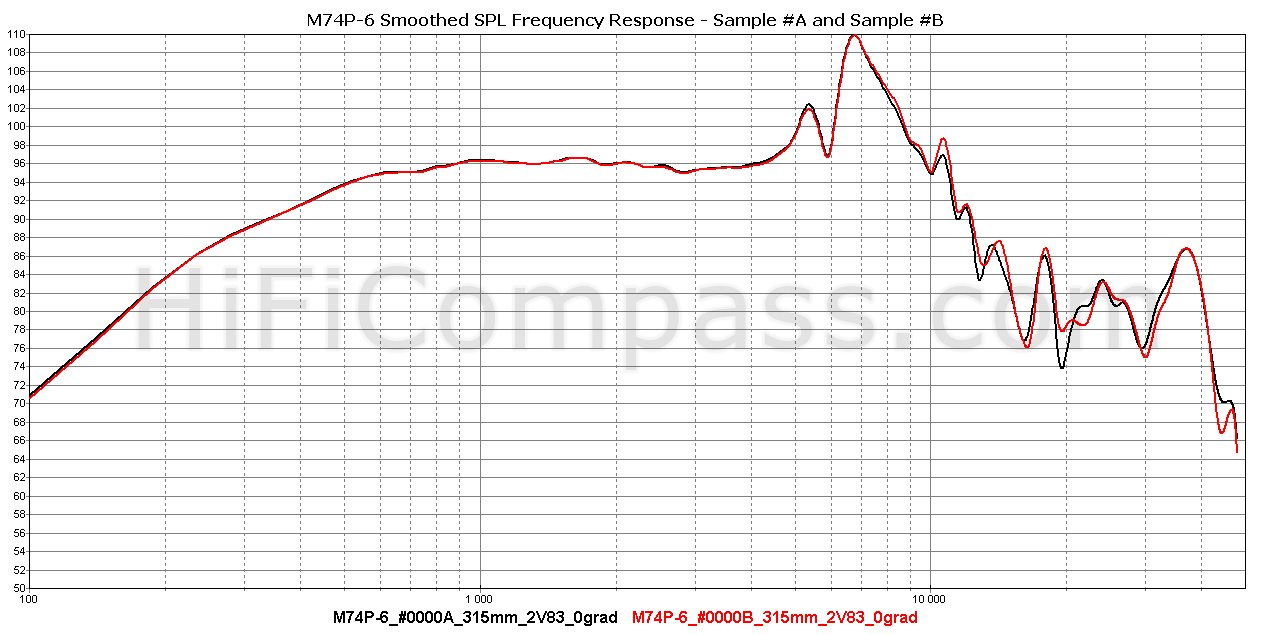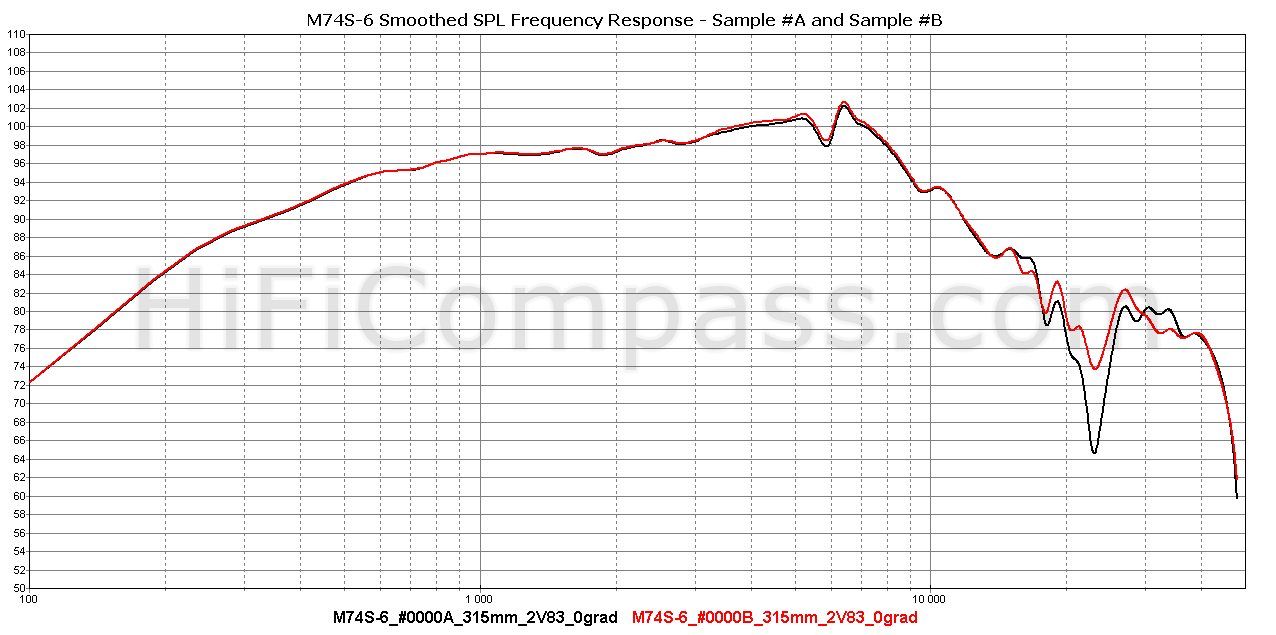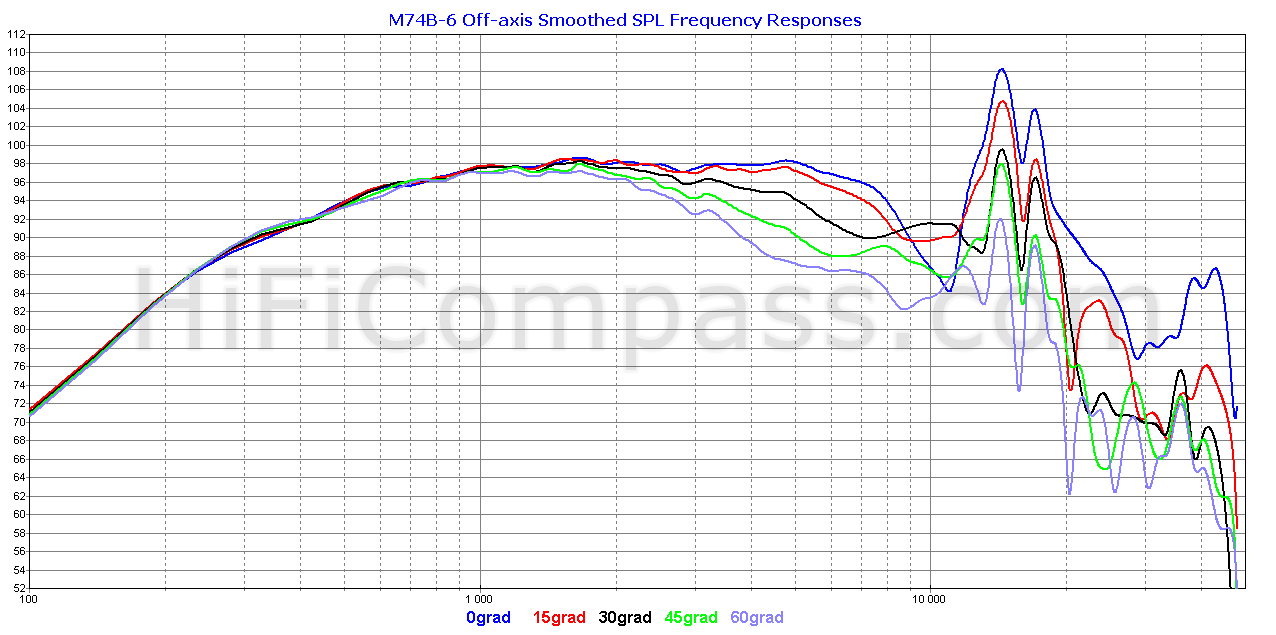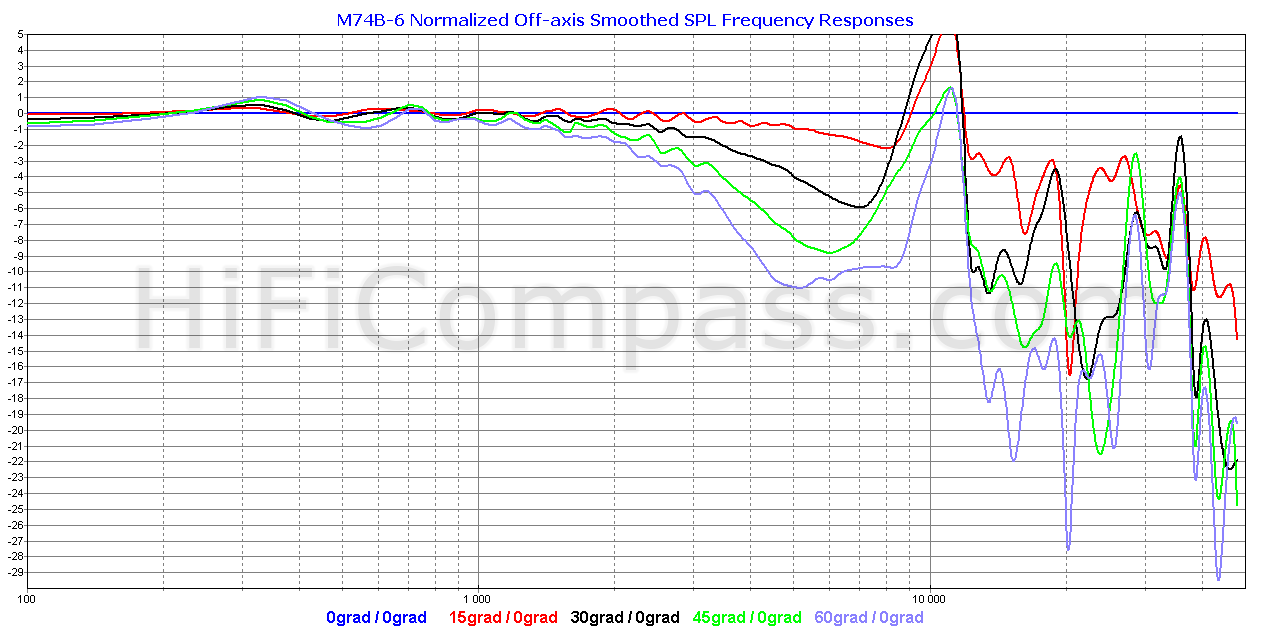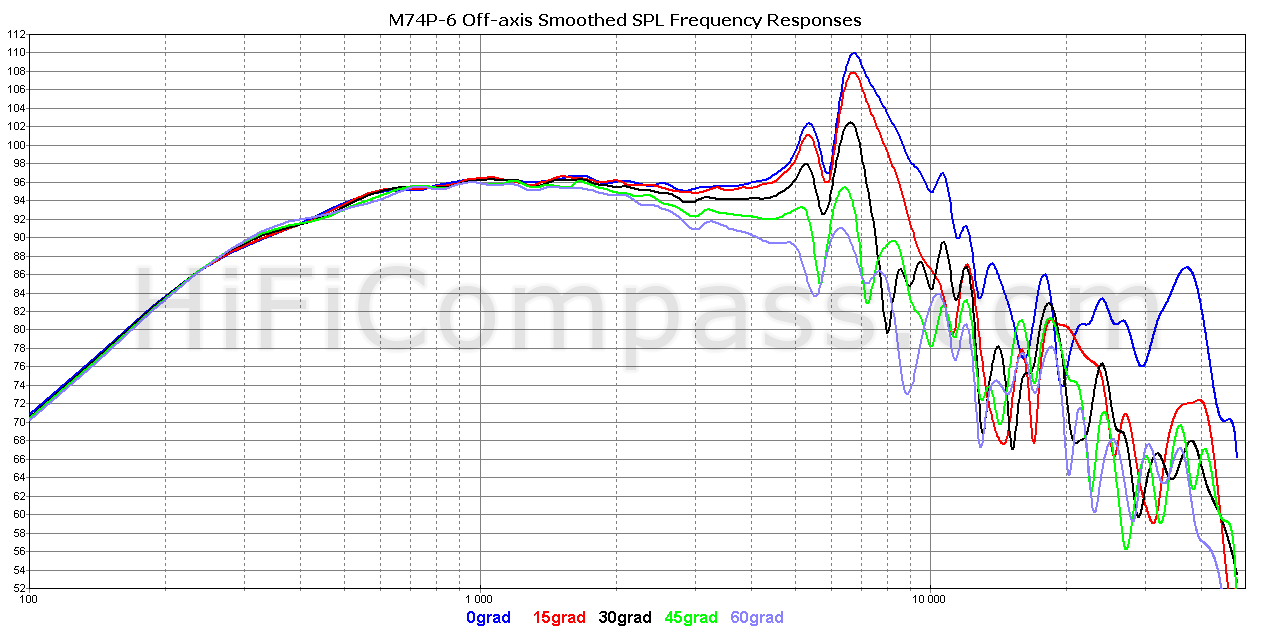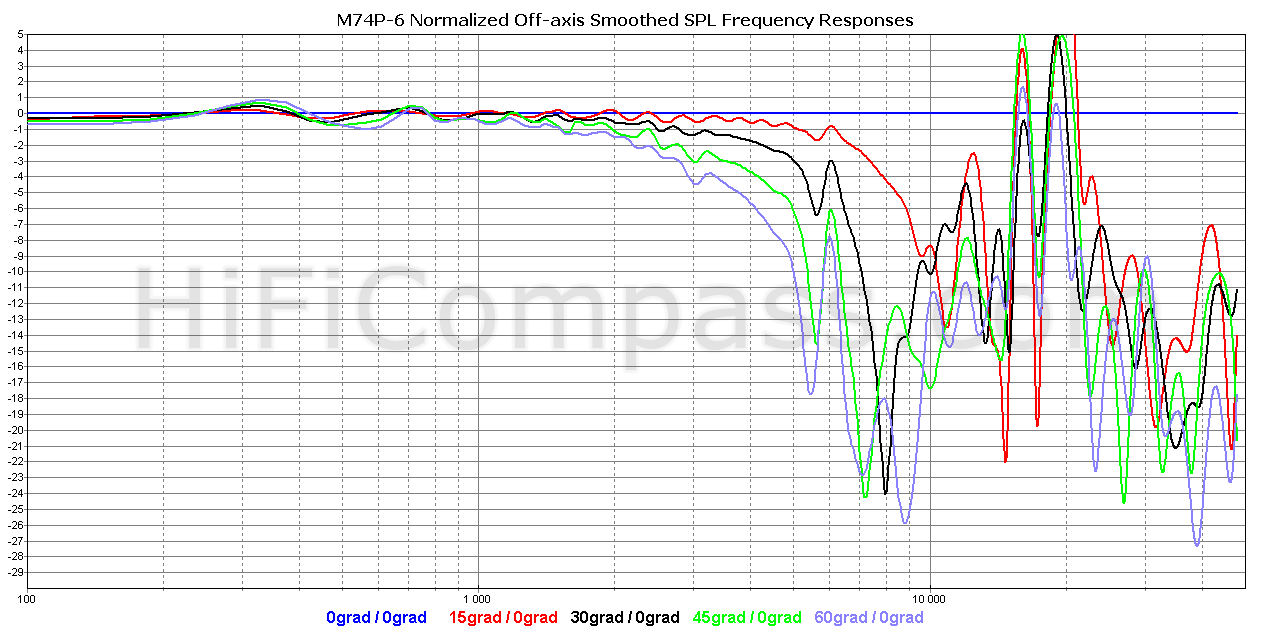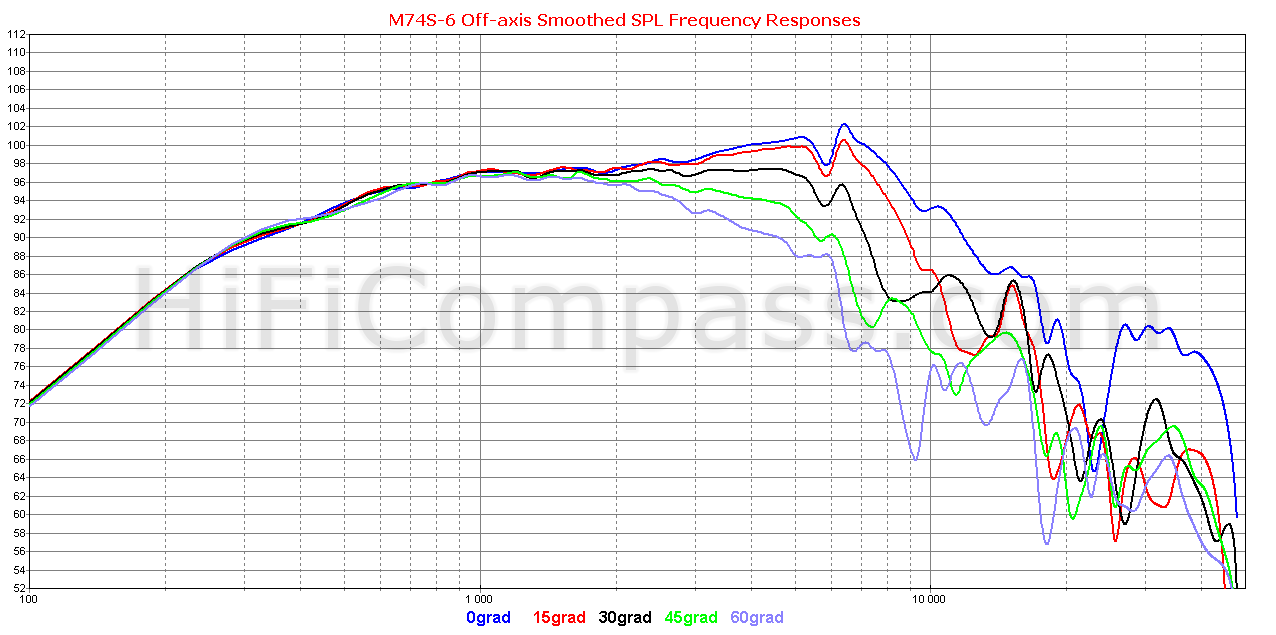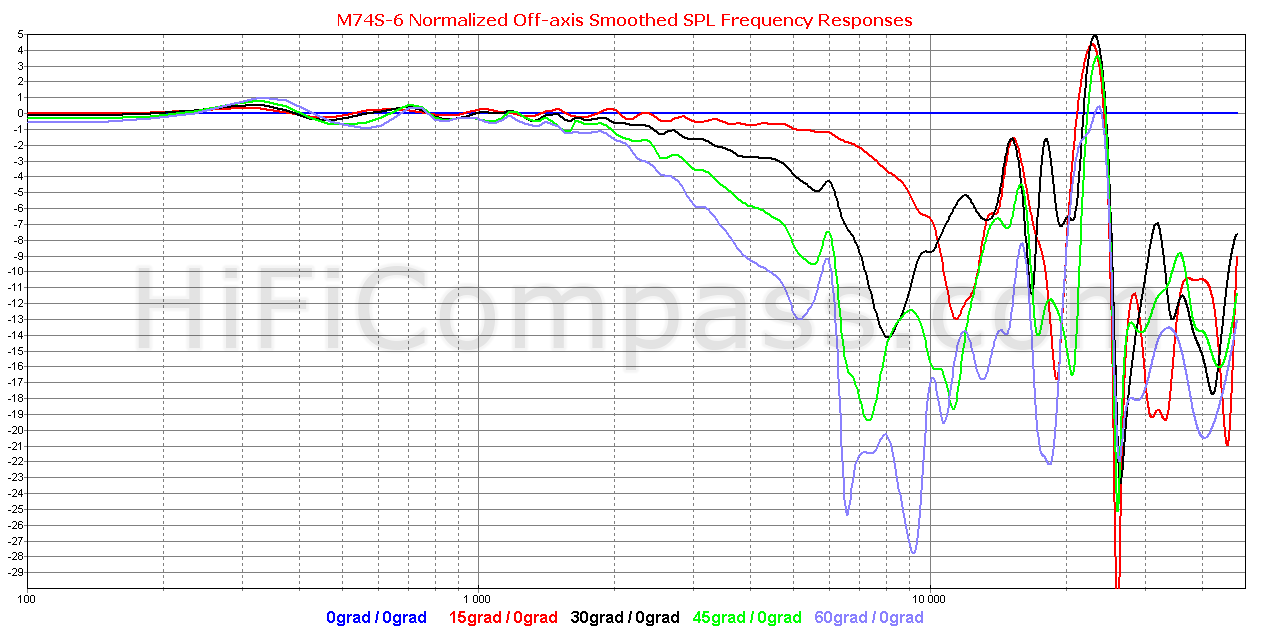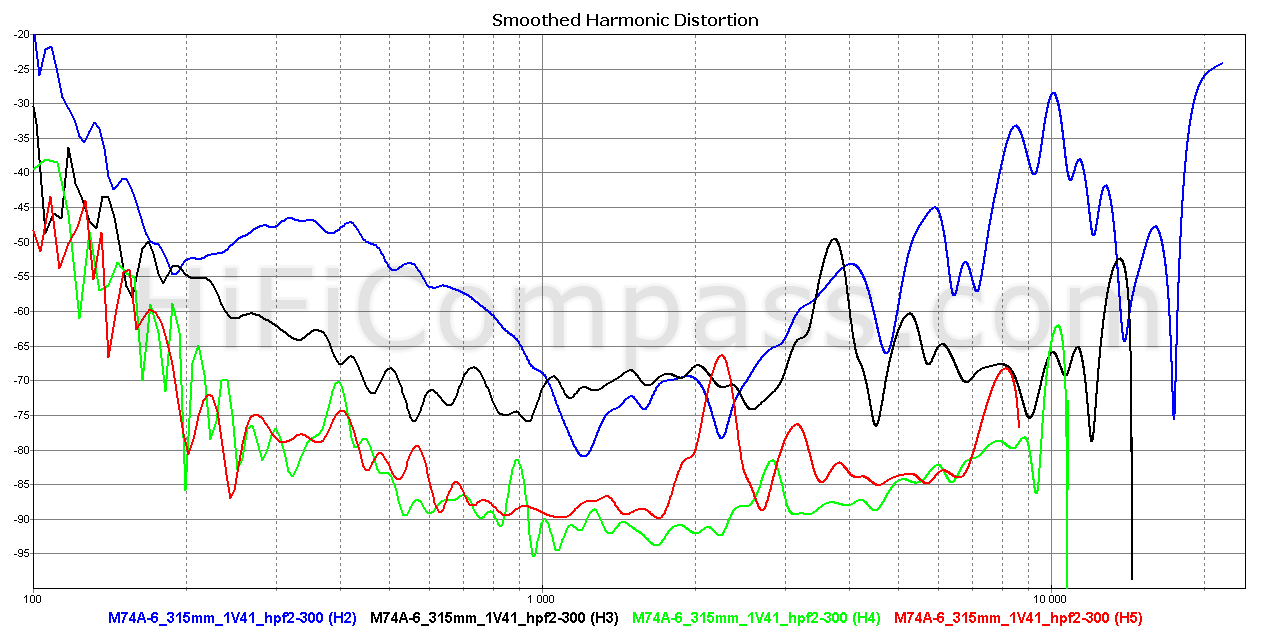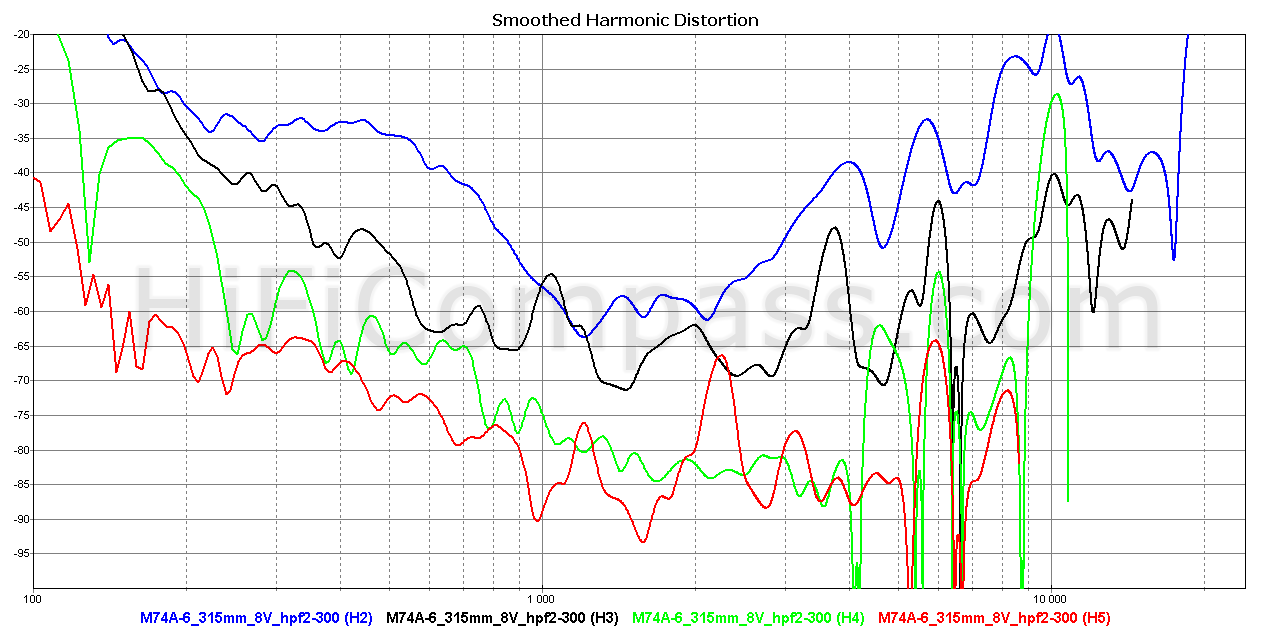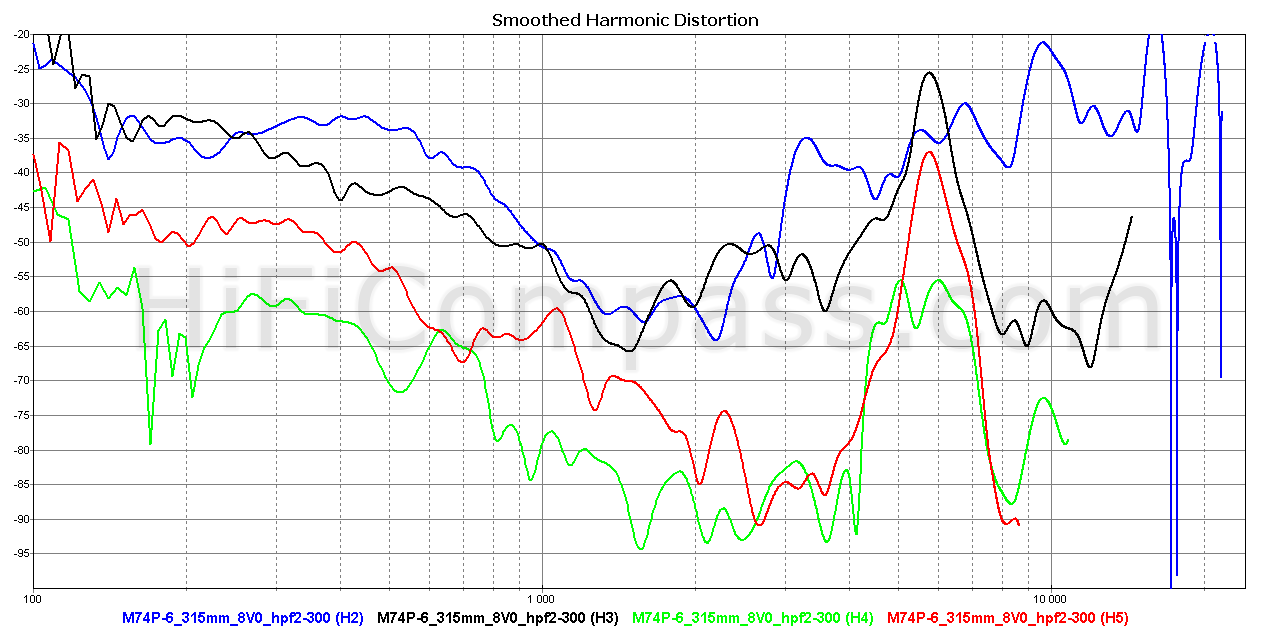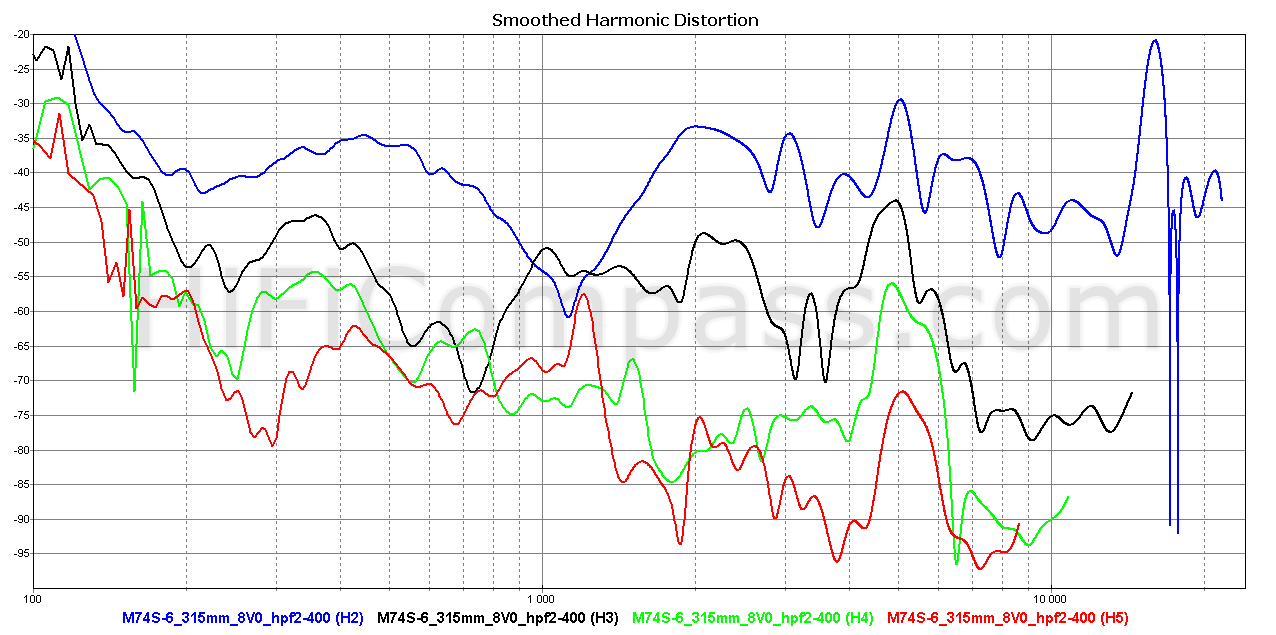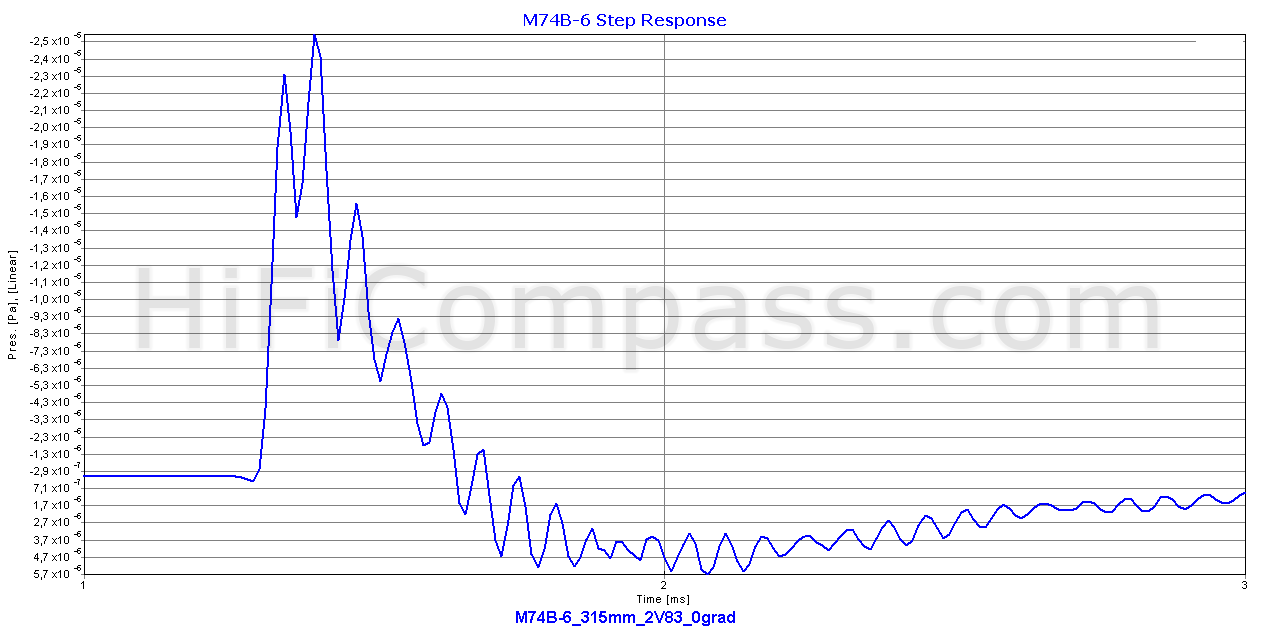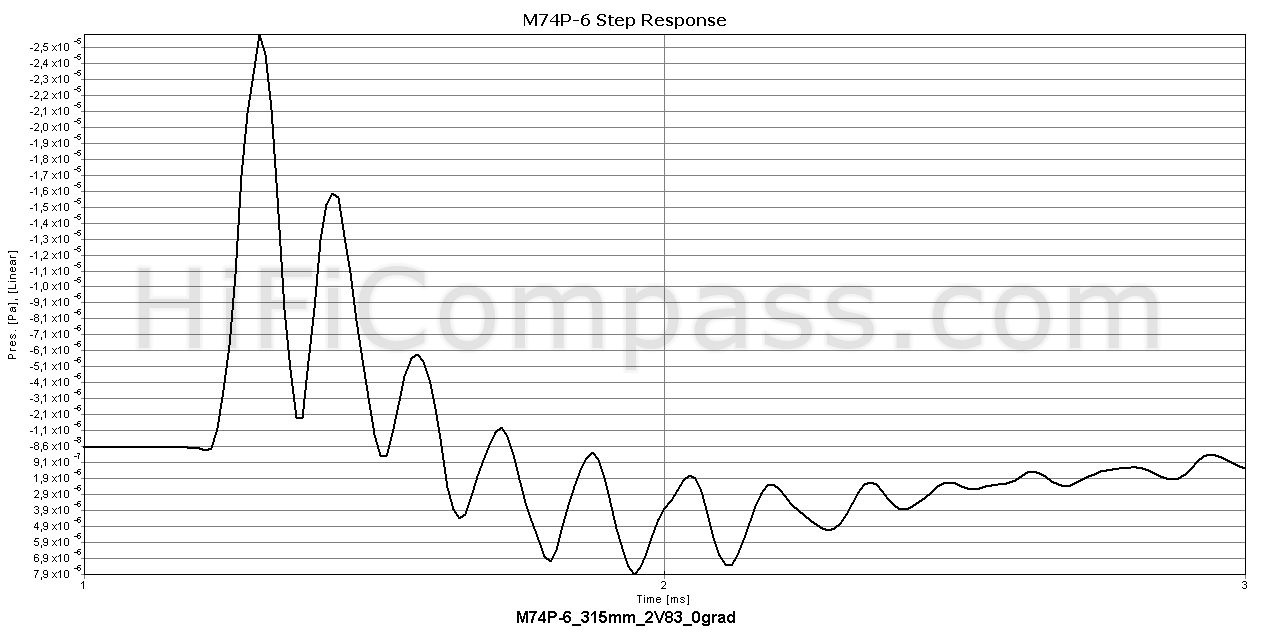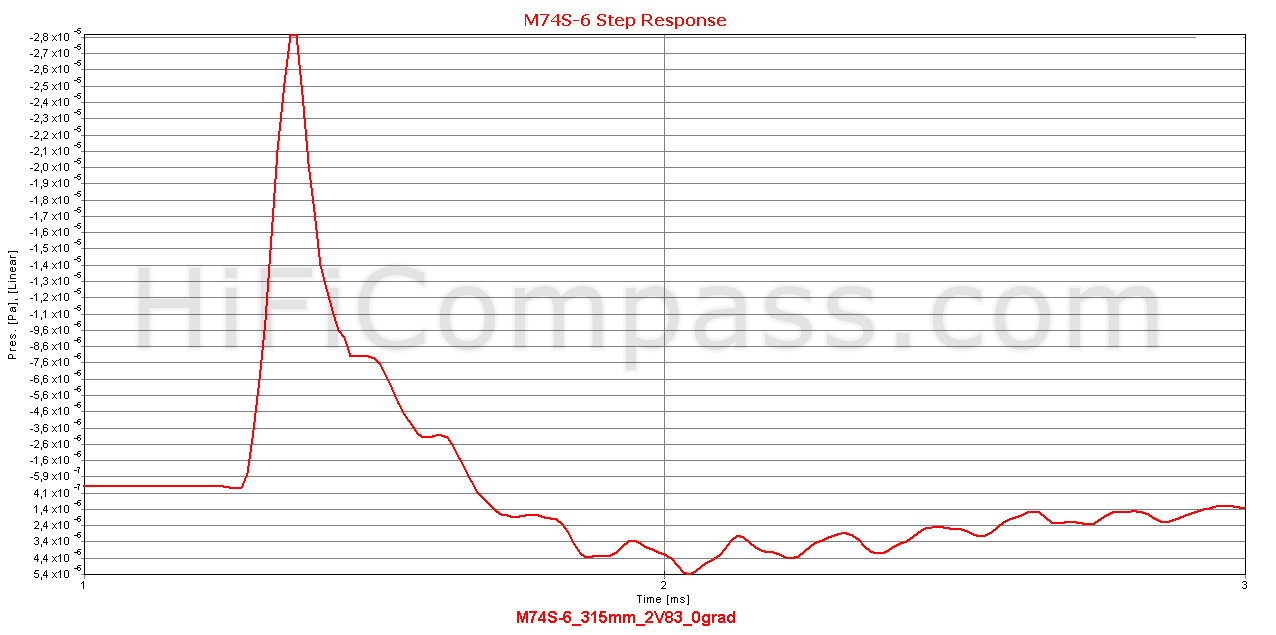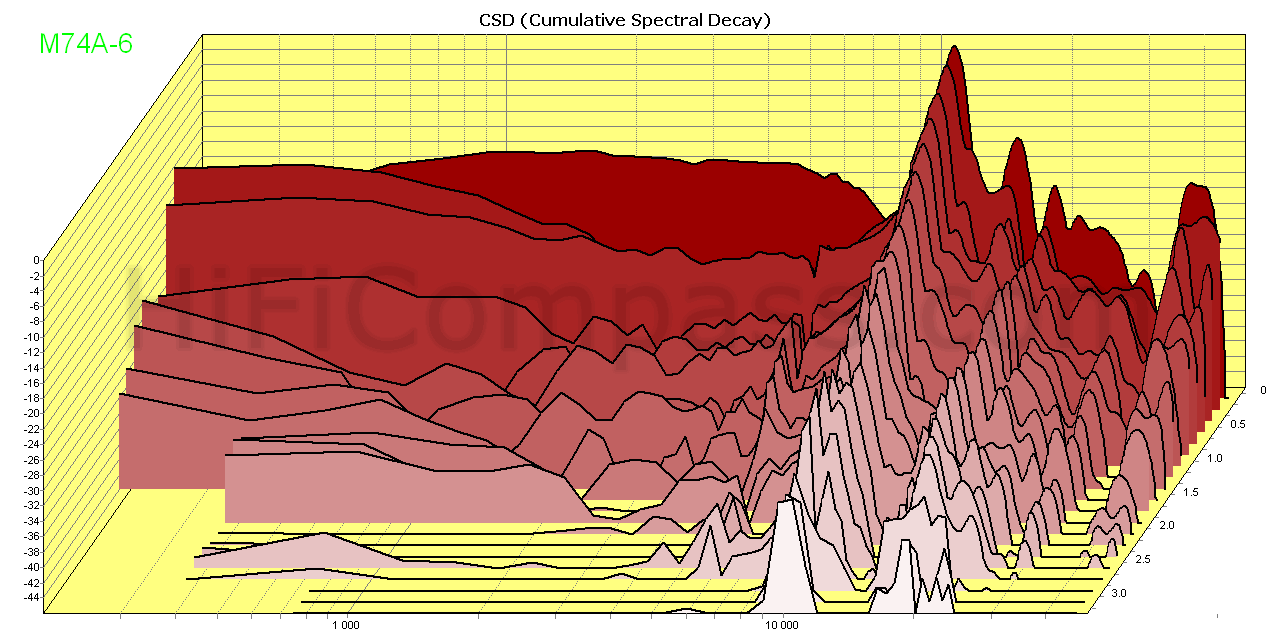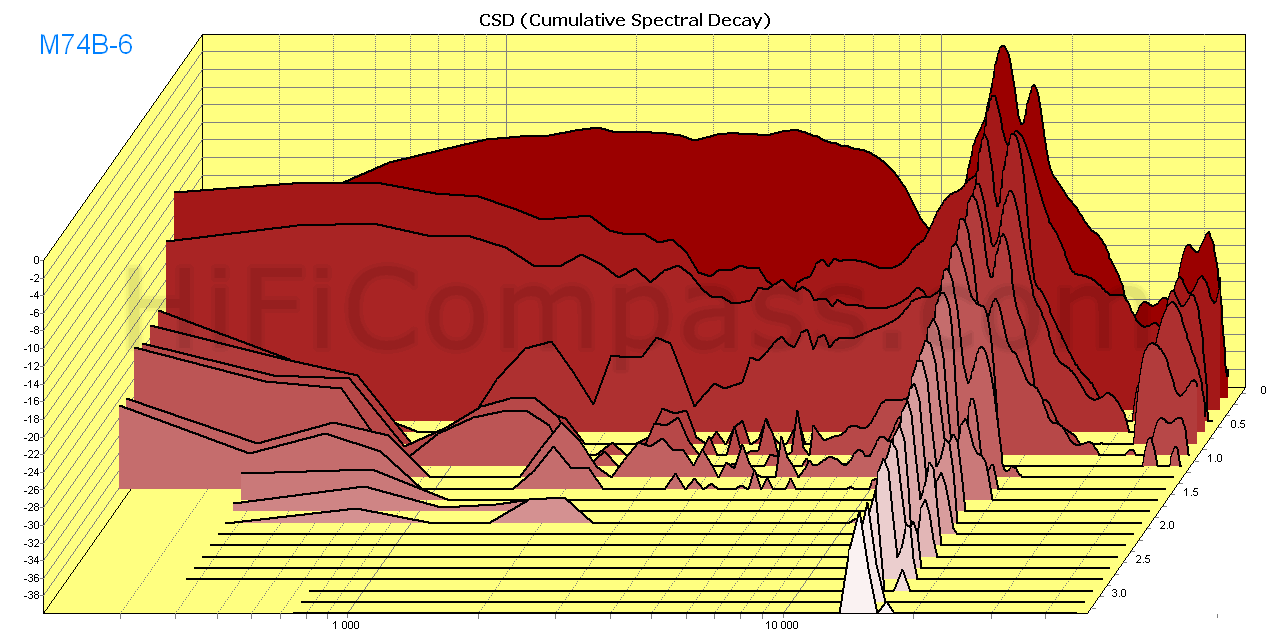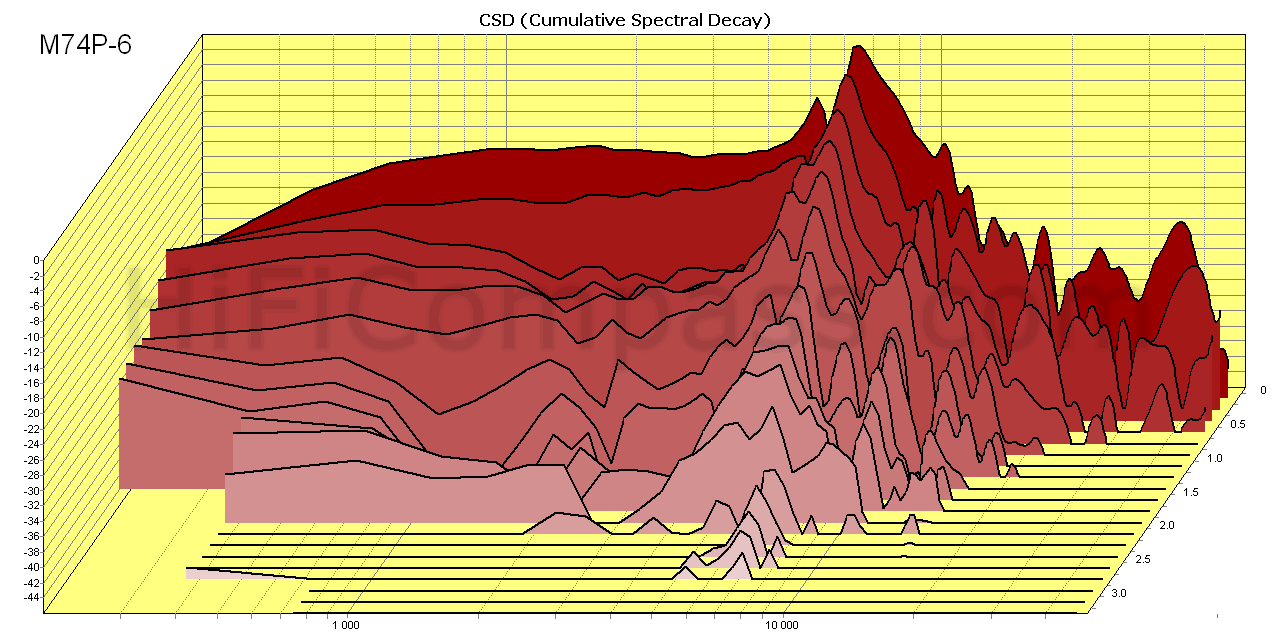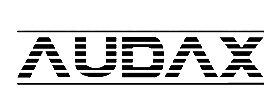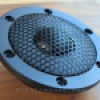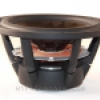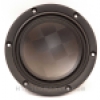HiFiCompass
BlieSMa M74A-6, M74B-6, M74P-6 and M74S-6
What is on the test bench?
In the end of 2021, the German company BlieSMa pleased the loudspeaker designers community with the release of a line of four 3" dome midranges at once, the development of which had been rumored for a long time. All models share the same chassis, but use different membranes for every taste and color, namely:
- M74A-6 with an Aluminum-Magnesium (AlMg) dome
- M74S-6 with a silk dome
- M74B-6 with a Beryllium (Be) dome
- M74P-6 with a paper dome
And if the materials of the first two items, most likely, will not cause much surprise and excitement, since they have been the basis of the vast majority of dome midranges over the past half century, then with the last two items everything should be exactly the opposite.
The first and the only one I know of 3" beryllium dome midrange of direct radiation (membrane diameter of 68 mm) under the name JA-0801 saw the light in the far 1974 as part of the legendary Yamaha NS-1000M loudspeakers. It was being produced until 1997, had several modifications and reached its technical apogee as part of the Yamaha NSX-10000 loudspeakers, timed to coincide with the company's 100th anniversary. These midrange speakers have never been commercially available, but were used exclusively as part of the company's top loudspeakers. So, the BlieSMa beryllium dome midrange is the second in history and was released with the intention of breathing new life into the somewhen very popular design, which, unfortunately, gone into oblivion.
To be fair, it should be noted that large 3" and even 4" beryllium membranes due to their unsurpassed acoustic properties (I recommend the very informative article by Stewe Mowry "The whole truth about beryllium diaphragms") have been used for many years and continue to be used in the top professional compression midrange drivers of such companies as TAD, JBL, Radian, Eighteen Sound, but this is a different principle of sound radiation and a completely different story.
As for the 3" paper dome midrange, it is unique at least in that it is the first serial 3" dome midrange speaker with a paper membrane known to me. What do you say, did I intrigue you? In the 70s of the last century, only 2" Philips AD0210/SQ paper dome midranges were produced and it seems nothing more. Quite a strange situation, because the technology of paper membranes has been studied far and wide, it is as old as the first dynamic loudspeaker in history. There are countless paper cone membranes, they still dominate the world market, but dome ones for some reason, the clarification of which is beyond the scope of this review, did not receive any attention. Although, fabric domes also belong to the category of soft membranes and very widespread in dome midranges.
In my review of the Satori MD60N-6 midrange speaker I speculated a little about the history of dome midranges. Since then, another fabric 3" midrange DM-7500 from the Chinese company SWAN has been released, and now four models from BlieSMa at once. Six models from well-known brands in just two years - what is it, is it really a renaissance of dome midranges?![]()
I will update the list of 2"-3" dome midranges produced in the past 50 years. Discontinued models are marked in red. This list does not claim to be complete. If you know of any other models, please write in the comments and I will update it:
Accuton (Germany) - C50-8-044 (2"), C51-6-286 (2"), BD51-6-585 (2")
ATC (UK) - SM75-150 (3"), SM75-150S (3")
Beyma (Spain) - MC115 (2")
BlieSMa (Germany) - M74A-6 (3"), M74B-6 (3"), M74P-6 (3"), M74S-6 (3")
Ciare (Italy) - HM500 (2"), HM600 (2")
Dayton Audio (US) - DC50FA-8 (2"), RS52AN-8 (2"), RS52FN-8 (2")
Dynaudio (Denmark) - D-52 (2"), D-52AF (2"), D-54 (2"), D-54AF (2"), D-76 (3"), D-76AF (3"), M560D (2")
Fostex (Japan) - FS80D (3"), FS32D (2"), TT50 (2")
Hi-Vi (Swan) (China) - DMA-A (2"), DMB-A (2"), DMN-A (2"), DM-7500 (3")
ITT (Germany) - LPKM130-50-120TT (2")
LPG (Germany) - 50FA (2"), 51AT (2"), MCD51 (2")
Morel (Israel) - MDM55 (2"), CAM558 (2"), EM1308 (2"), MDM-75 (3"), MDM-85 (3")
Peerless (Denmark) - 821639 (2"), 821694 (2"), 821646 (2")
Philips (Netherlands) - AD0210/SQ (2")
Pioneer (Japan) - DS-047A (3")
Satori (Indonesia) - MD60N-6 (2.5")
ScanSpeak (Denmark) - D7608/9200 (3") (former VIFA D75MX-41-08)
SEAS (Norway) - H204 (3"), 76MF H304 (3")
Tang Band (China) - 50-1426SA (2"), 75-1558SE (3")
Visaton (Germany) - G50FFL (2"), DSM50FFL (2")
Volt (UK) - VM527 (2"), VM752 (3")
Yamaha (Japan) - JA-0801 (3"), JA-0802A (3"), JA-0803 (3"), JA-0521 (2")
As in the case of the BlieSMa T25-6 tweeters I decided to make one group review, in which it would be easier to compare midranges with each other and focus on their distinctive features.
Here you can get familiar with the BlieSMa history.
Why do we test this?
Until now, all BlieSMa products (T25A-6, T25B-6, T25D-6, T25S-6, T34A-4, T34B-4) have been the embodiment of competent engineering, based on the use of the most modern materials and technologies, and have been surprising with their objective technical parameters and characteristics. But so far it has only been tweeters. Today we are talking about dome midranges and four different membrane materials - how can this be uninteresting? Will BlieSMa surprise me again? As the famous hero of Anthony Hopkins said, "There is nothing more beautiful in life than trying new things".![]()
I would like to express my deep gratitude to Stanislav Malikov for the kindly provided pre-production samples for independent testing.
What did the manufacturer state?
The datasheets are quite detailed and contain all the parameters a loudspeaker designer needs.
As the review has comparative character, at first I'll list the features that are common for all models:
- Extremely low moving mass for better transient response and higher efficiency- really record low values among all speakers known to me with an effective radiation area of about 50 cm2:
2.3 grams for aluminum and paper membranes,2 grams for silk and only 1.8 grams for beryllium ones
- Fully saturated neodymium motor with copper sleeve for low non linear and modulation distortion
- 2.4 mm linear excursion and large vent channel for undistorted low-end frequency operation- 2.4 mm is from peak to peak, i.e. 1.2mm per side
- No ferrofluid for improved dynamics
- Textile surround covered by faceplate with moderate horn loading for flat frequency response and wide off-axis response
- Single-layer ribbon CCAW voice coil for lower inductance
- Underhung voice coil wound on titanium former
- Flexible and lightweight lead wires made in Denmark
- Thick aluminium powder coated flange
- Aluminium rear chamber with natural wool damping
- Gold plated wire terminals
Of all the numerical parameters it should be noted:
- low inductance - 0.036 mH
- high sensitivity - from 95 to 97 dB/2.83Volt*1m
- high mechanical quality factor - Qms from 6.4 to 7.6 (only the paper version has it lower for some reason - Qms=3)
Now let's take a look at individual features:
M74A-6:
- 74 mm AlMg alloy dome with variable thickness for higher first breakup mode
- Recommended frequency range Fs - 6 kHz
M74B-6:
- 74 mm beryllium dome for wide bandwith and low non linear distortion
- Recommended frequency range Fs - 8 kHz
M74P-6:
- 74 mm paper dome developed together with Dr.Kurt Muller
Dr.Kurt Muller (Germany) is a world famous and recognized leader in the production of various loudspeaker components. The company was founded in 1934 in Berlin. Today it supplies components to many of the world's leading speaker driver manufacturers - Recommended frequency range Fs - 4.5 kHz
M74S-6:
- 74 mm natural silk soft dome with integrated surround
The words "natural silk" carries exactly the meaning that it carries, namely, a dome made of natural silk, and not of synthetic fabrics, as is the case with the vast majority of manufacturers today - Recommended frequency range Fs - 4.5 kHz
Resonant frequencies cannot be attributed to record low, they are all in the region of 400 Hz. I think that with such a low-mass moving system, a huge 74 mm voice coil and a single-point suspension system, it is still possible to obtain lower Fs values, but already dangerous from the point of view of voice coil stability in a narrow magnetic gap.
As you can see, the midranges inherited most of the technologies and materials from their small predecessors - tweeters. The claimed high sensitivity (95 - 97 dB) goes hand in hand with the very low mass of the moving system (1.8 - 2.3 grams), which is one of the cornerstones of BlieSMa's high fidelity sound reproduction philosophy. A set of all the features and parameters unequivocally allows us to attribute the speakers to the top class.
Visual inspection
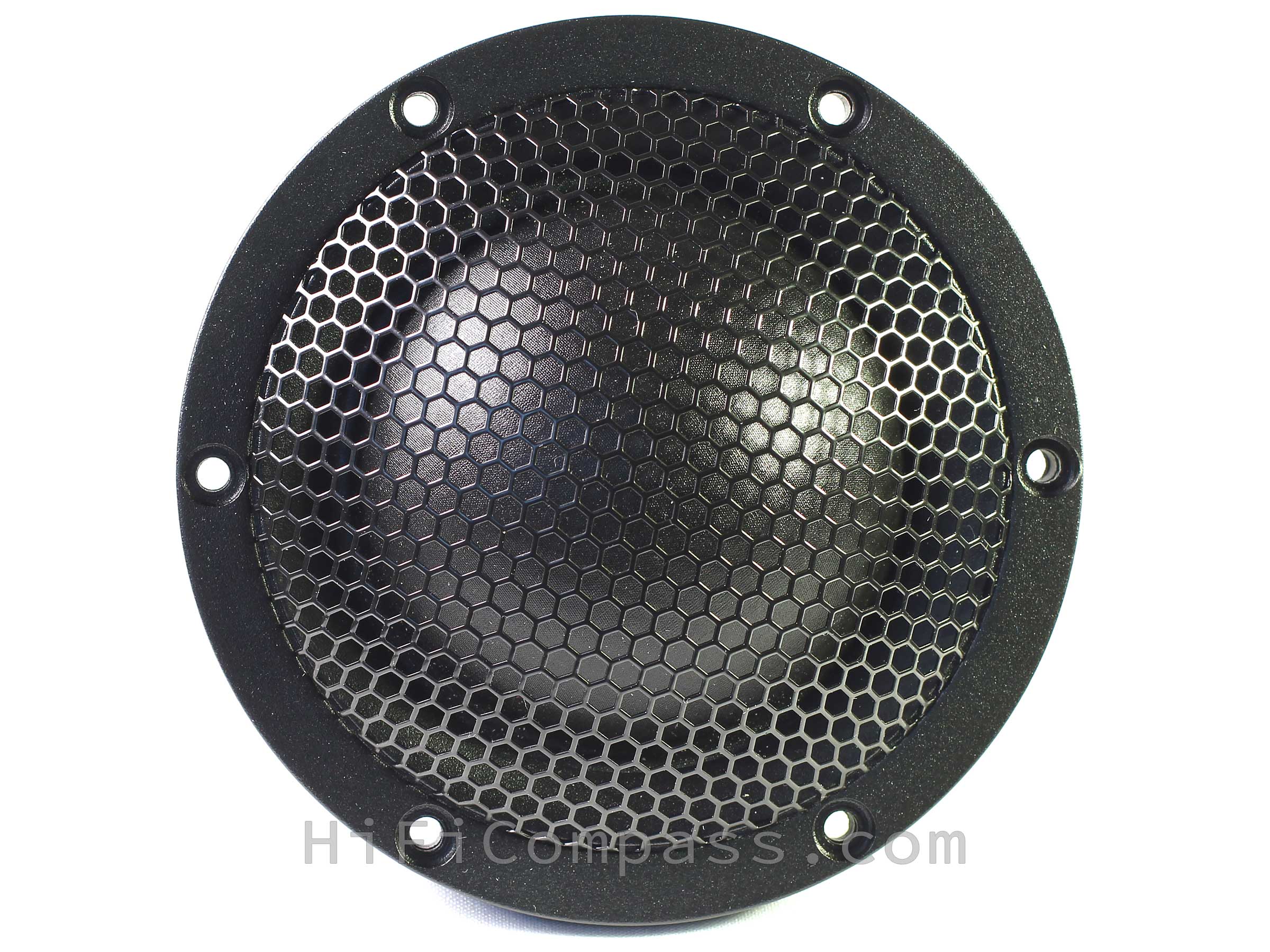 |
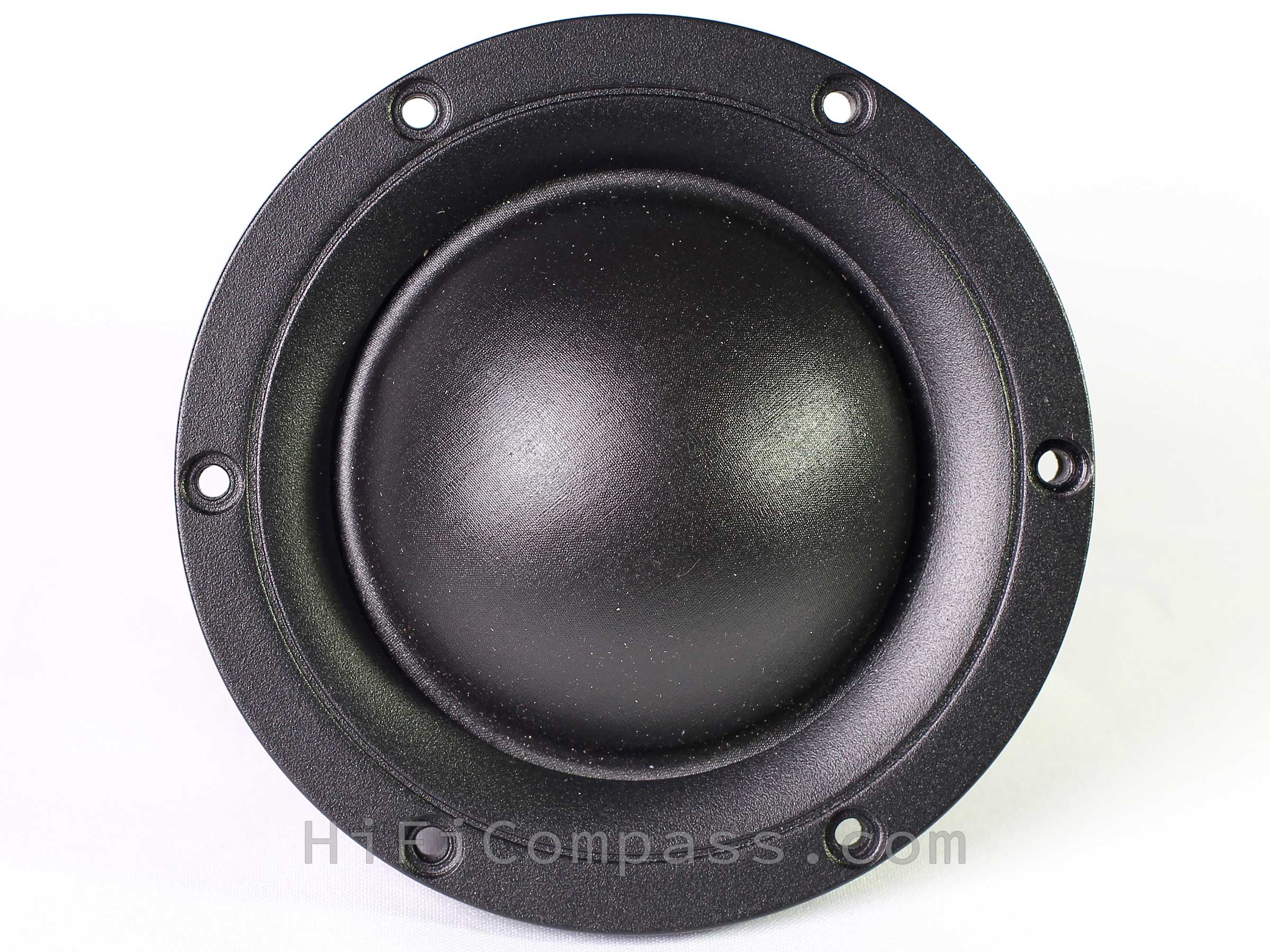 |
 |
 |
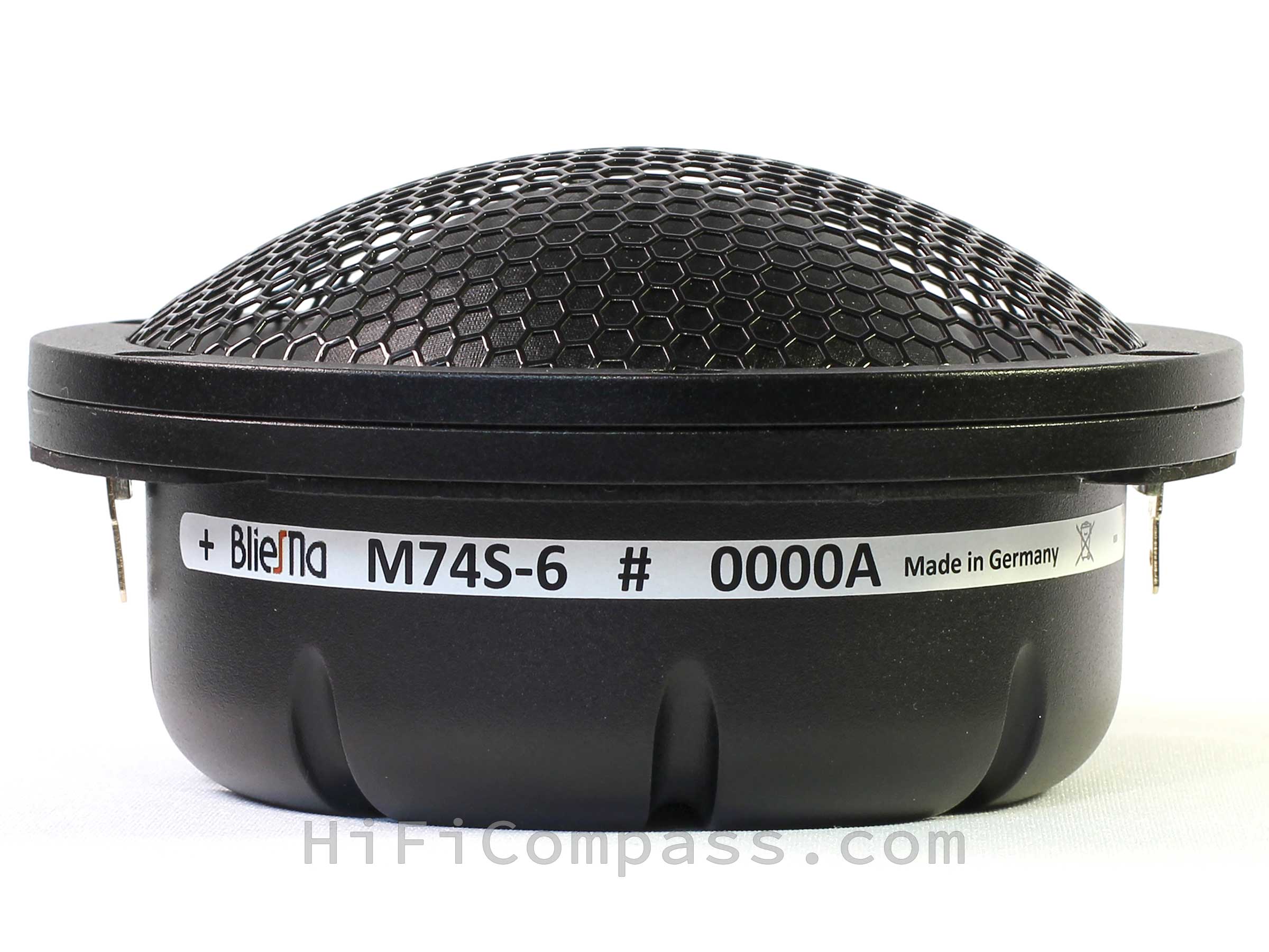 |
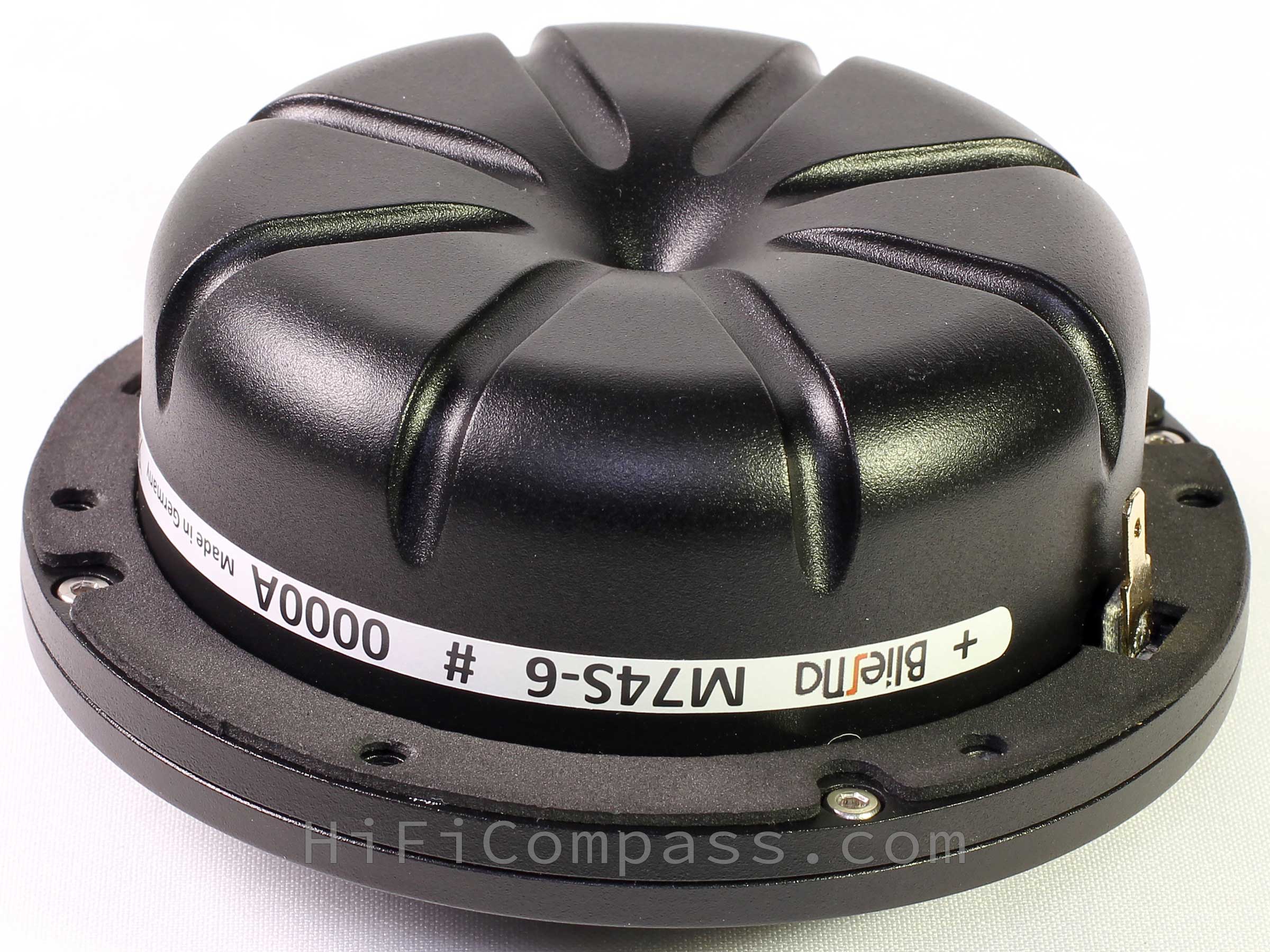 |
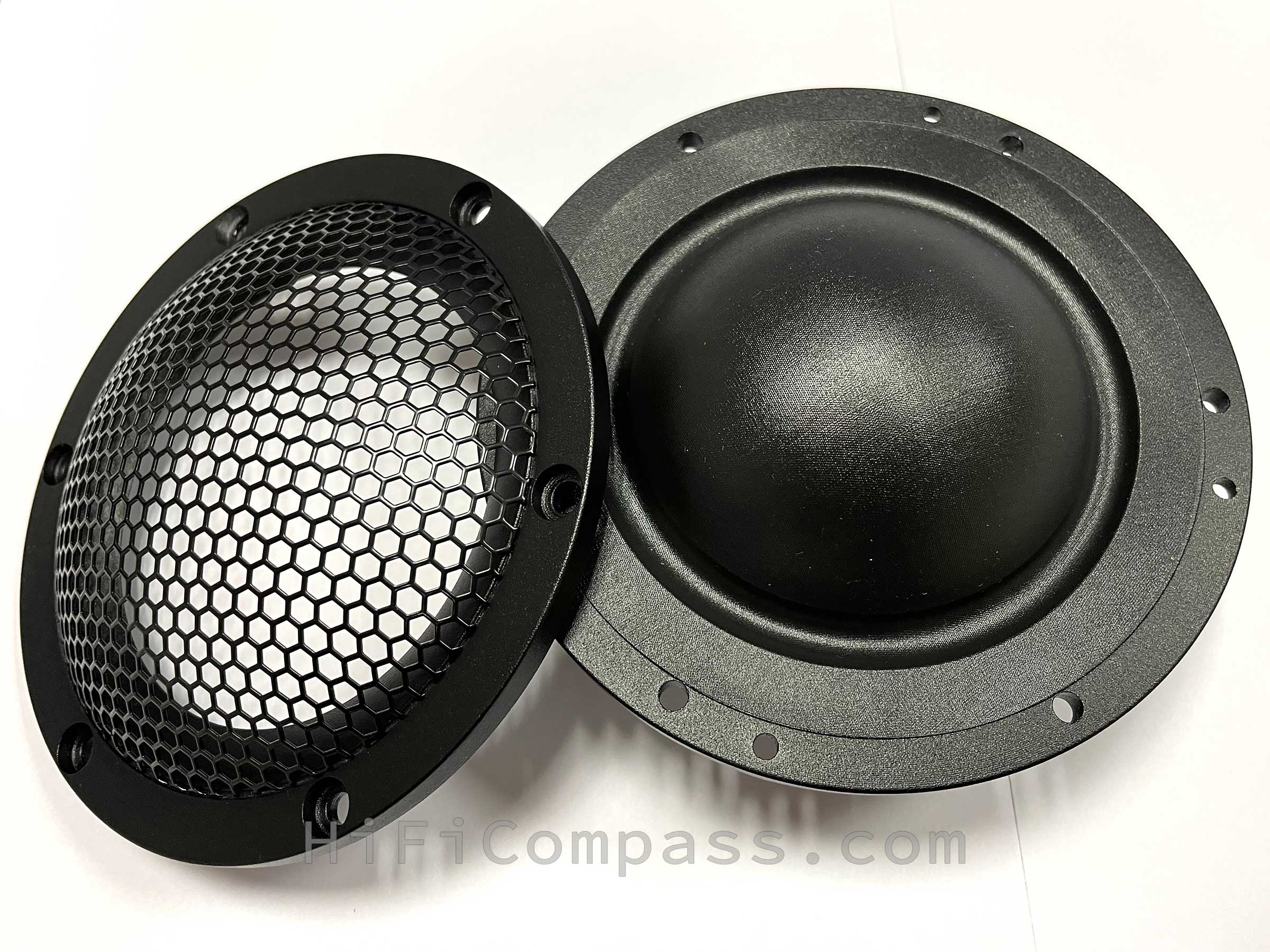 Structural parts that can be detected by visual inspection include a protective grille, mounting flange, dome membrane, surround, rear chamber and terminals.
Structural parts that can be detected by visual inspection include a protective grille, mounting flange, dome membrane, surround, rear chamber and terminals.
- Protective grille is made of stamped steel with a smooth powder coating. Acoustic transparency is at least 65-70%. There are no any unpleasant sounds when tapping with a finger on it. Despite the fact that in the picture you can see the speakers without a grille, in reality it is not removable and is glued into a narrow groove in the mounting flange. For DIYers - in case of critical need, it can be removed without any problems.
-
The mounting flange is made of solid aluminum with a pleasant microtexture powder coating. It consists of two parts, front and rear, 5 mm thick. The rear part is the main and bearing part, to which the foam rubber gasket, moving and magnetic systems are attached. The front part is the base for the protective grille. It hangs slightly over the fabric surround and thus creates a small waveguide load for a frequency response correction.
In principle, the front part is removable as it joins to the rear part with four screws, the heads of which are visible from the back. Such a design solution makes it easy to provide the speaker with any waveguide of your own design instead of the original flange. A useful option, as it helps to expand the applicability of the midrange, however, there is one "but" that I was strictly warned about - due to the assembly process and construction features, any attempt to remove the front part of the flange in the series model will cause a misalignment of the moving system. Therefore, to be on the safe side, you must contact a manufacturer and order this option in advance.
So, guys, before turning any screws, I advise you to think three times and propose to consider this option as undocumented, but potentially possible. - The beryllium dome membrane with a distinctive grey-matte color has the lowest profile. The semi-gloss black anodized aluminium-magnesium membrane has a slightly higher profile. The paper and silk domes have the highest and very close profiles to each other.
The black matte paper dome material is quite hard, while the silk dome is noticeably soft and looks very similar to the dome material of the BlieSMa T25S-6 silk tweeter. - The surround - fabric, concave and slightly covered by the mounting flange.
- Rear chamber seals the speaker and forms an internal cavity filled with a sound absorber of natural wool. It is die-cast aluminum part with the same micro-textured powder coating as the mounting flange. On the back side it has eight radial stiffening ribs and a conical recess in the central part, which forms a corresponding scattering cone in the inner cavity to reduce the reflection of the sound wave coming from the back side of the membrane.
Despite its cast construction, thickness and stiffening ribs, when tapped with a finger, the rear chamber slightly responds, therefore, I would not call it absolutely inert. - Gold plated spade terminals of different widths for the positive and negative poles are deadly glued into the rear flange and are absolutely motionless.
- Serial numbers 0000A and 0000B indicate that I have in my hands the first pre-production samples.
The production quality is at the highest level and fully corresponds to the status of the product. No traces of glue, scratches, dirt, dust, stains and dents on the membranes, chips or cracks. Absolutely nothing to complain about.
It is especially worth to note the size of the speakers. This is the most compact 3" dome midrange drivers ever existed. With an effective radiation area of 50.25 cm2 the diameter of the mounting flange is only 121 mm. This contributes to the minimum center to center distance between a midrange and a tweeter, which is important at very high crossover point frequencies.
So, I can say that we have a very compact, thoughtful and well-realized design.
Impedance frequency response
Above are the impedance curves of all models in large and small scales. What do these pictures say?
- Perfect speaker matching in pairs. It's important and great.
- The actual resonant frequencies turned out to be even slightly lower than the declared values. It's not very important, but definitely better than the other way around.
- The mechanical quality factor Qms of the aluminum-magnesium, beryllium and silk versions turned out to be lower than the declared values, while for the paper version, on the contrary, it is a bit higher. From my point of view, it's not as important for tweeters and dome mids as it is for woofers operating down to their main mechanical resonance frequency.
The only, purely academic interest for me is why the height of the resonant peak and Qms of the paper version in the datasheet and measured values are noticeably lower compared to other versions? - In the frequency range up to 4.5 kHz, the impedance curves are very flat, almost perfect, except for a slight bulge around 3 kHz, which is present in all versions. Moving systems can hardly be the cause, because they are all different, but the effect is the same. Most likely, this is a sign of incomplete absorption of radiation from the rear side of the membrane. The importance of this will be determined by further frequency response and distortion measurements.
- Above 5 kHz the membranes begin to go into a "break-up" mode, which is reflected by spikes in the impedance. Of course, the beryllium version behaves best here, everything is perfectly clean up to 15 kHz, and the paper version is the worst - starting from 5 kHz, the first dome resonance begins to manifest itself. The silk version also shows a change in behavior, but does it very gently and barely noticeable.
- The increase in impedance from a minimum at 2 kHz to a maximum at 20 kHz does not exceed 45%, which indicates a very low inductance of the voice coil, which, in turn, is achieved due to a short single-layer winding and a copper sleeve on the pole of the magnetic system. Good motor.
On-axis frequency response
The frequency responses of all models perfectly match each other in a pair, excellent!
M74A-6:
The measured sensitivity in the range of 600 Hz-5 kHz averaged 95 dB, which coincides with the datasheet value. The frequency response in this range is very even and smooth, the total unevenness does not exceed +/- 1 dB.
The measured sensitivity in the range of 600 Hz-5 kHz averaged 97.5-98 dB, which exceeds the declared value (97 dB) by 0.5-1 dB. The frequency response in the range of 900 Hz-6 kHz is very even and smooth, the total unevenness does not exceed +/- 1 dB.
The measured sensitivity in the range of 600 Hz-4 kHz averaged 96 dB, which exceeds the declared value (95 dB) by 1 dB. The frequency response in the range of 600 Hz-4 kHz is very even and smooth, the total unevenness does not exceed +/- 1 dB.
The measured average sensitivity in the range of 600 Hz-4 kHz, I would estimate as 97 dB, which coincides with the declared value. The frequency response in the range of 600 Hz-4 kHz is very smooth, slightly increasing from 2 to 5 kHz due to the beginning of "soft breaking" of the dome, therefore, the total unevenness from 600 Hz to 4 kHz does not exceed +/- 2.5 dB.
Off-axis frequency responses (315 mm)
Above are the plots of the regular and normalized off-axis frequency responses. On the normalized plot the axial frequency response is taken as the reference one, and the off-axis ones reflect only the difference with it.
M74A-6:
If we evaluate the integral sound power radiated by a speaker in the range of frequencies and angles up to 10 kHz/60 degrees, then the AlMg version undoubtedly has the widest sound dispersion. All off-axis characteristics smoothly and monotonously decrease with increasing frequency and deflection angle up to 7 kHz. No hidden resonances or surprises.
M74B-6:
The beryllium version follows the aluminum in sound dispersion width. All off-axis characteristics smoothly and monotonously decrease with increasing frequency and deflection angle up to 8 kHz. No hidden resonances or surprises.
M74P-6:
The paper dome midrange is inferior to AlMg and Be in terms of integral dispersion up to 10 kHz/60 deg, however, it behaves best in the range up to 4 kHz. All off-axis characteristics smoothly and monotonically decrease with increasing frequency and deflection angle up to 8 kHz. No hidden resonances or surprises.
M74S-6:
The silk dome version radiates less sound power compared with all its colleagues. All off-axis characteristics smoothly and monotonically decrease with increasing frequency and deflection angle up to 8 kHz. No hidden resonances or surprises.
The measured off-axis characteristics are in good agreement with the datasheets.
Harmonic distortion (315 mm)
Above are the harmonic distortion frequency responses for the 2nd - 5th harmonics for each model at the following average sound pressure levels:
M74A-6 - 89 and 104 dB (at voltages of 1.41 and Volt, respectively)
M74B-6 - 92 and 107 dB
M74P-6 - 90 and 105 dB
M74B-6 - 91 and 106 dB
To limit the speaker overload in terms of power and membrane displacement, when measuring harmonic distortion, a second-order high-pass filter with a cutoff frequency of 300 Hz was used.
M74A-6 and M74B-6: both perform worthy and maintain approximate parity at 90 dB SPL. They demonstrate low distortion in the 500Hz-5kHz frequency range and very low distortion in the 900Hz-3kHz range.
At frequencies of 2.2 and 3.7 kHz for AlMg and 2.9 and 4.7 kHz for Be we can see bursts of the 3rd and 5th harmonics. These bursts are due to the voice coil current harmonics amplified by the main resonance of the membrane. With proper crossover design they can be significantly neutralized. This is exactly the case when passive loudspeaker filters can have advantages over active filtering.
With an increase in sound pressure up to 104 - 107 dB, an increase in all harmonics is observed, especially pronounced with a decrease in frequency, and the 2nd harmonic becomes clearly dominant. Above 5 kHz, the aluminum-magnesium version has harmonic bursts caused by the diaphragm "breakups", while the beryllium behaves much more stably. Despite everything, the overall level of distortion is still low. In the range of 800 Hz-3.2 kHz at a SPL of 106 dB the total distortion does not exceed 0.56%!
M74P-6: The paper model has low distortion, but is not nearly as good as AlMg and Be.
Firstly, there is a stronger increase in the 3rd harmonic below 1.2 kHz with an increase in the sound pressure level.
Secondly, there is a higher level of the 3rd harmonic in the range of 1.7-3 kHz.
And thirdly, there is a sharp rise in the 3rd, 4th and 5th harmonics at 5.6 kHz of the main resonance of the membrane, which is observed at all levels of the input signal. It is this rise that will fundamentally limit the maximum possible operating frequency of the speaker.
M74S-6: The silk version can be considered a competitor of the paper version in terms of distortion. Silk is better in all harmonics, except for the second one, which in the range of 1.2-3 kHz noticeably exceeds the paper dome. But, as you know, the second harmonic is far from the most harmful to the ear. Everywhere outside this range, silk wins.
Summarizing, it can be noted that the nature of the frequency behavior of harmonic distortion is largely similar for all models and can be rated as low for M74P-6 and M74S-6 and very low for M74A-6 and M74B-6.
Voice coil current harmonic distortion
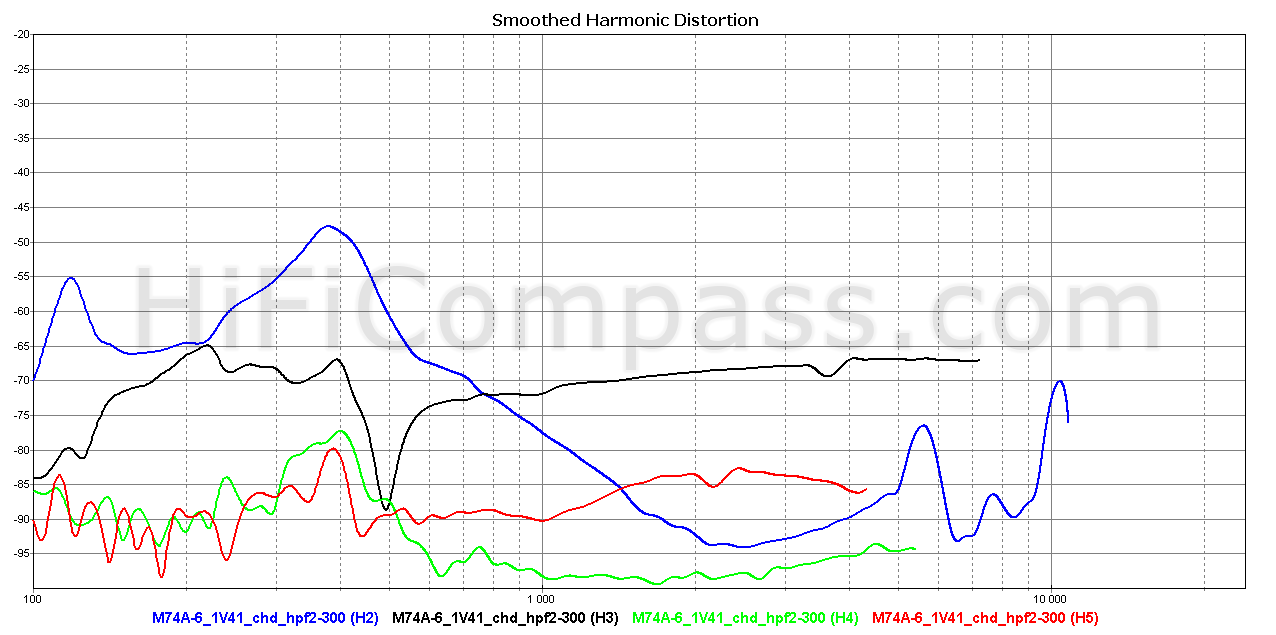 |
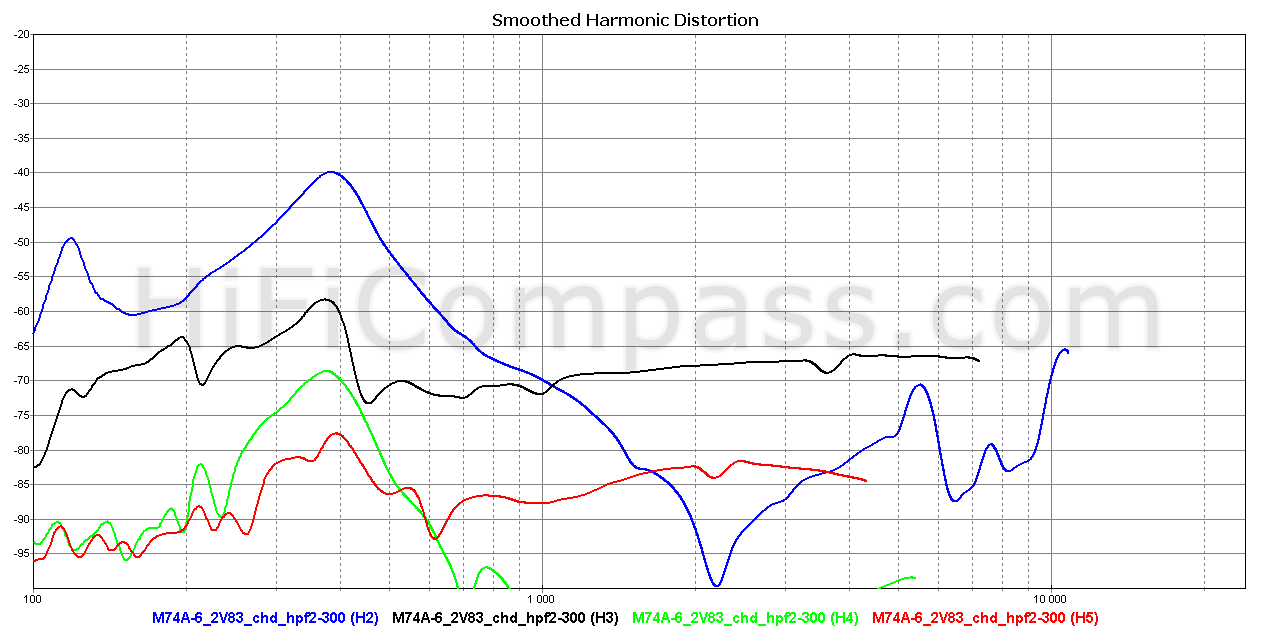 |
 |
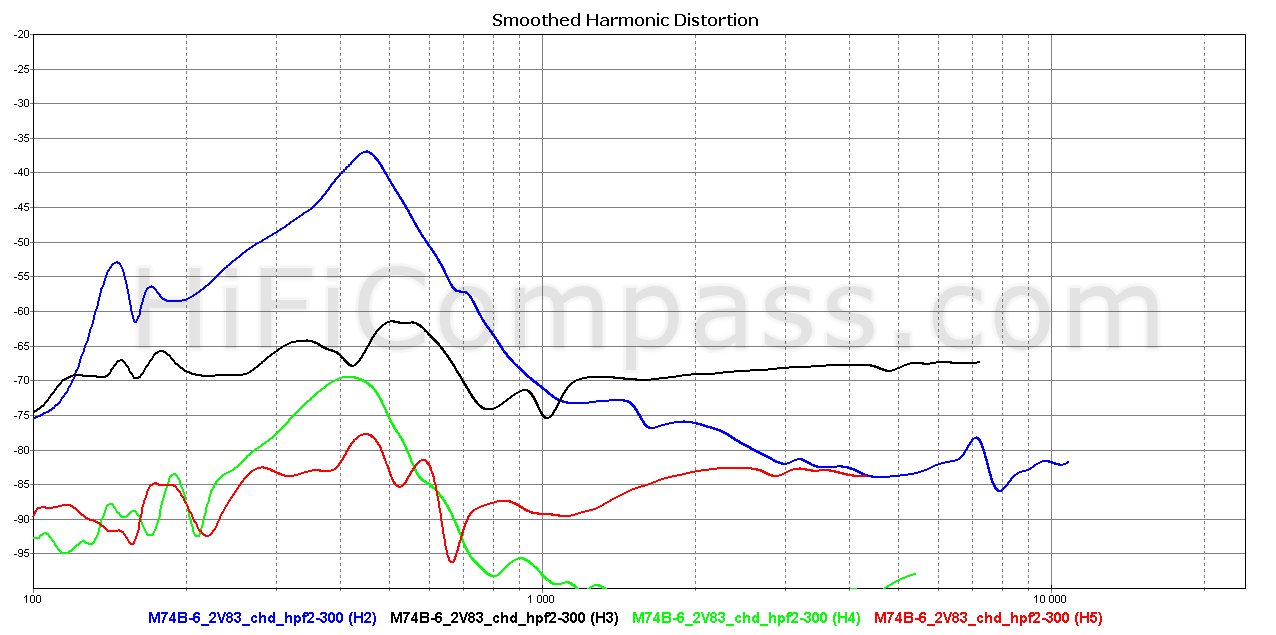 |
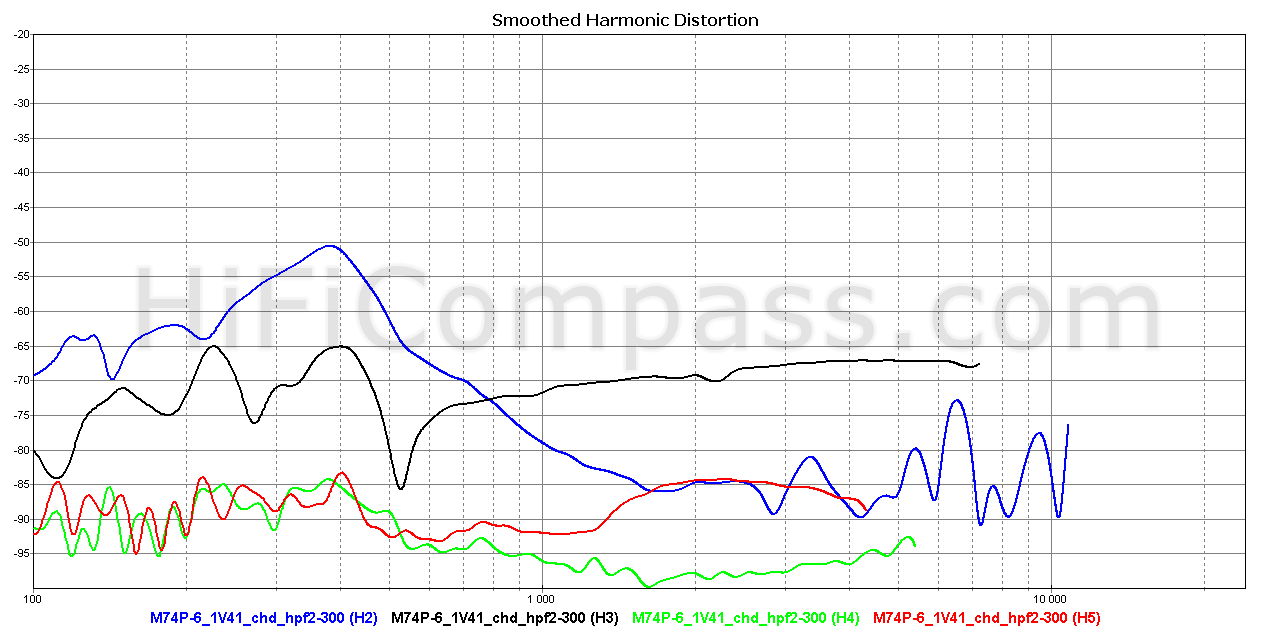 |
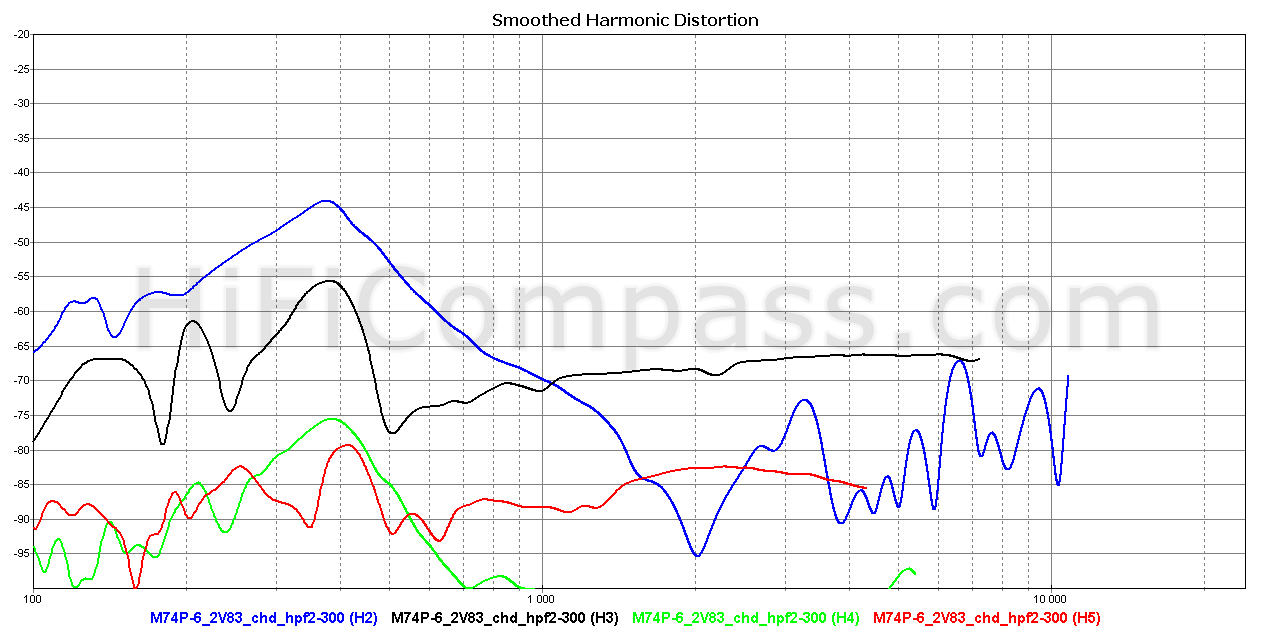 |
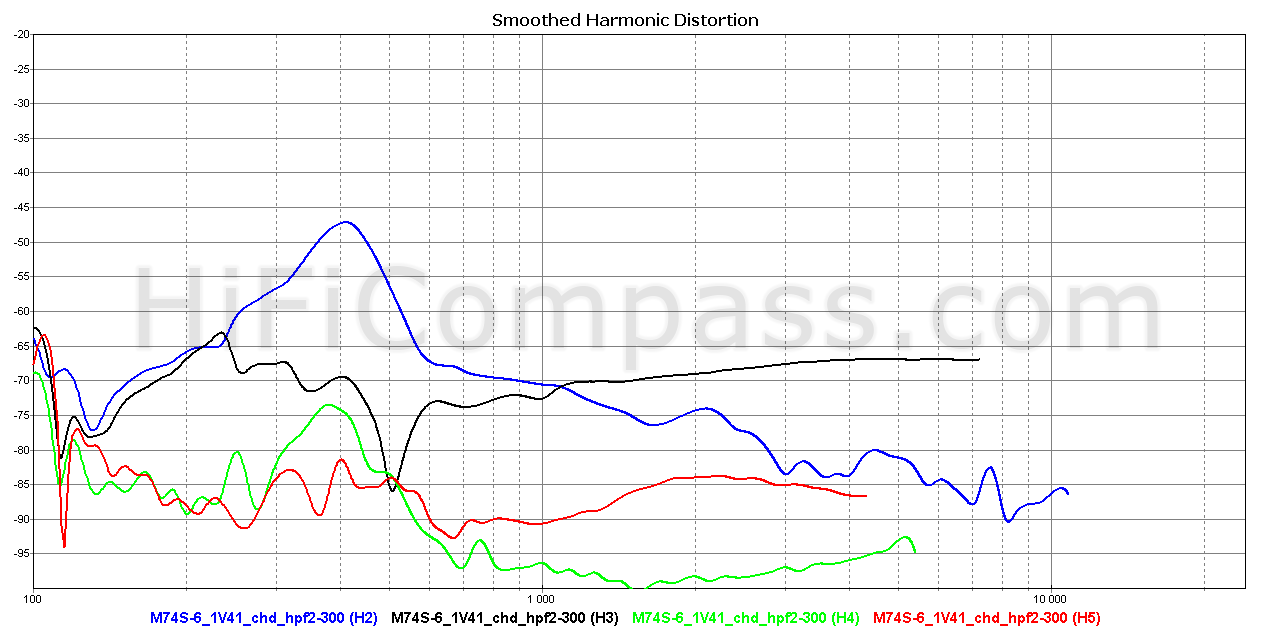 |
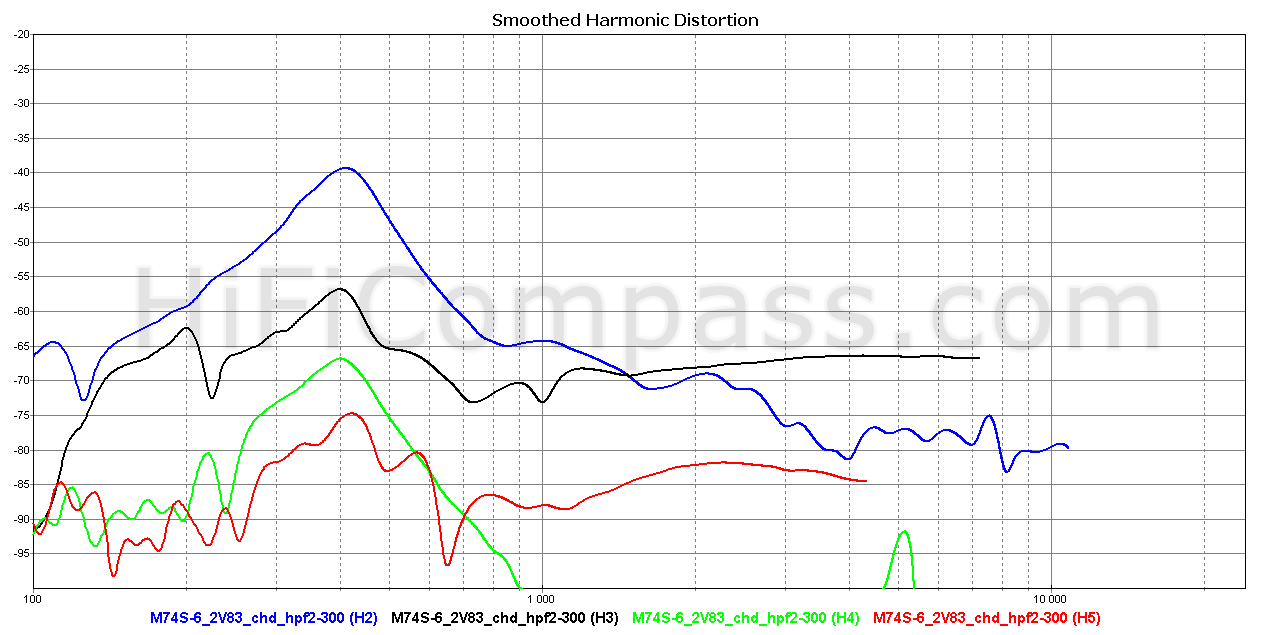 |
This type of measurement, despite its simplicity, is an excellent tool for assessing a speaker motor linearity. The above plots show the frequency dependences of the 2nd, 3rd, 4th and 5th harmonics of the voice coil current at 1.41 and 2.83 Volt. To limit the speaker overload in terms of the membrane displacement when measuring harmonic distortion, a second-order Butterworth type high-pass filter with a cutoff frequency of 300 Hz was used.
Voice coil current nonlinearity is the direct nonlinearity of the mechanical force driving the speaker cone, since this force is related to the current by a simple relationship F=B*L*I, where B is the magnetic field strength, L is the length of the voice coil wire inside the magnetic gap and I is the current. So, in principle, it is practically impossible to obtain sound pressure distortion lower than current distortion in the frequency range where the contribution of the motional nonlinearity becomes insignificant.
The fourth harmonic of the current is the lowest of all and down to 700 Hz it can be ignored. The behavior of the third and fifth is very weakly dependent on the voltage level. The fact that in the paper version it does not increase with decreasing frequency suggests that the reason for its increase in sound pressure is not the motor, but the moving system.
The second harmonic of the current also depends linearly on the voltage level, as well as the sound pressure does. As the frequency decreases, it gradually increases, however, starting from a certain point, the curve breaks and the growth accelerates. At the input voltage of 2.83 Volts this point is about 800 Hz for the M74A-6, M74P-6, M74S-6 and about 1kHz for the M74B-6.
I would rate the voice coil current harmonic distortion as "low".
Intermodulation distortion
The intermodulation distortion measurement is one of way of analyzing device non-linearity. It is not an alternative, but the additional method, which allows you to identify the spectral components of the inharmonious structure, which are much more harmful for high-quality sound reproduction and to which our hearing is more sensitive.
Testing was carried out at 2 volts for a pair of frequencies of 500 Hz and 4.25 kHz within the potential operating frequency range of the midranges. This is the most severe test mode, since the 500 Hz signal stimulates the biggest excursion of the moving system and, so, the biggest modulation of the high frequency components.
The measurement mode is indicated in the lower left corner of each graph, the results are in the upper right. The different colors are marked:
- test frequencies
- 2nd order intermodulation distortion amplitude (IMA2)
- 3rd order intermodulation distortion amplitude (IMA3)
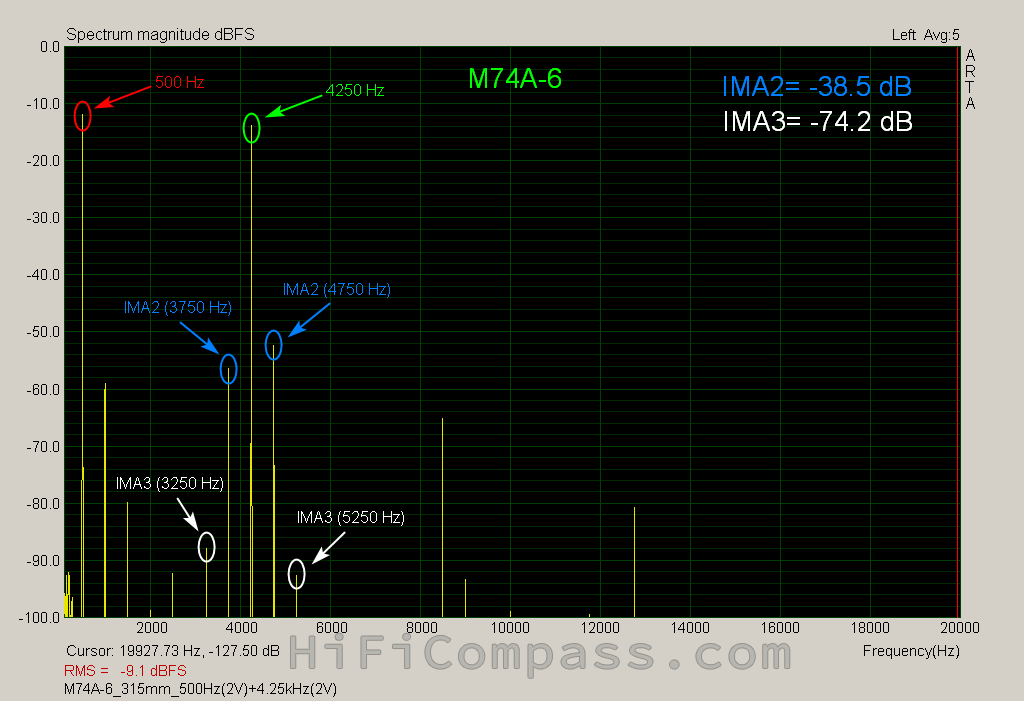 |
 |
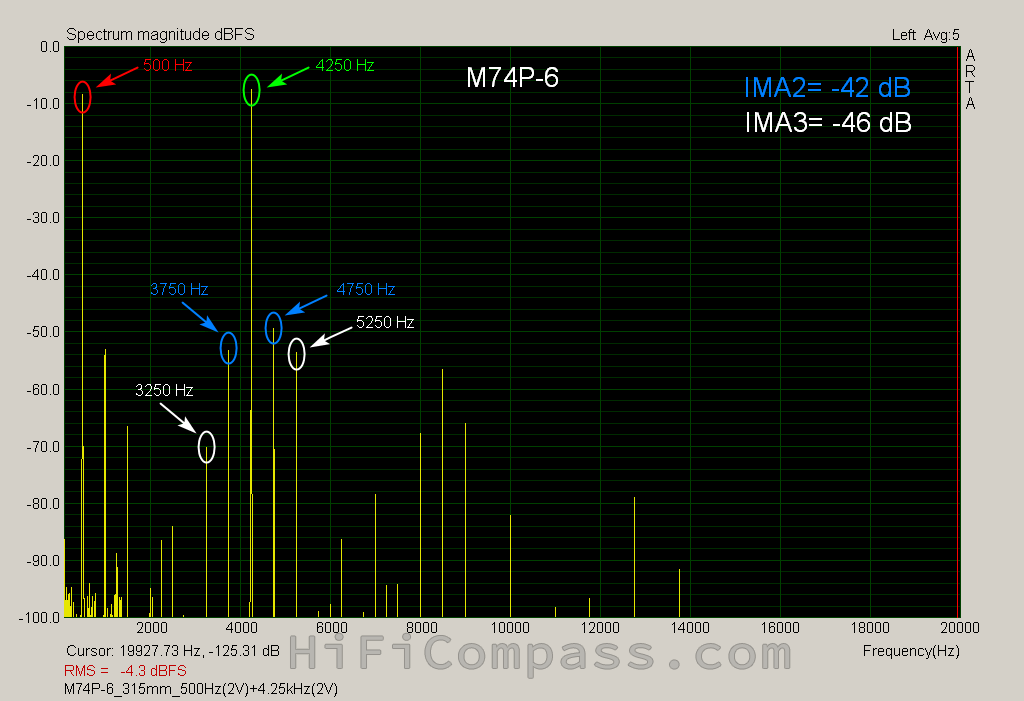 |
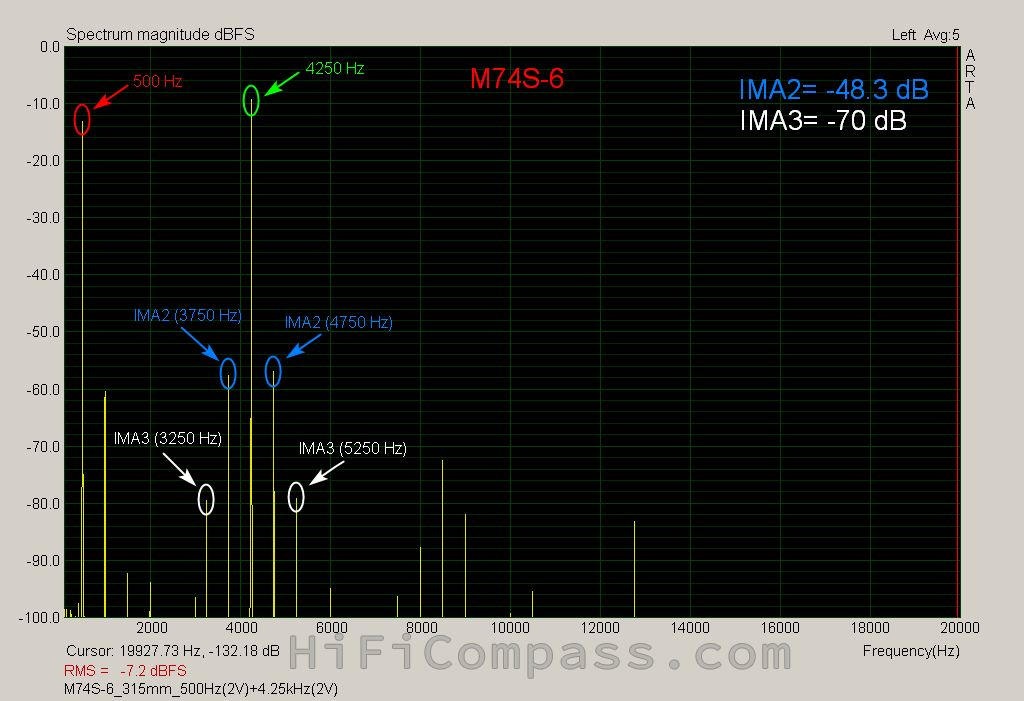 |
The best results for the two components IMA2 and IMA3 were shown by the silk dome, followed by beryllium, then aluminum, and the paper version closes the top four. However, despite the best IMA2 for silk, the spectra of aluminum and beryllium are cleaner. The "richest" spectrum turned out to be for the paper version.
I would rate the intermodulation distortion of all speakers as "low".
Step response
The step responses demonstrate excellent slew rate and fast decay. The return to rest going on rather quickly, crossing the zero line only once. Everything is quite acceptable. Due to the absence of strong zigzag traces of the main membrane resonances, the step response of the silk version looks much more attractive to the others. With proper filtering in a loudspeaker crossover, all of this ripple will disappear and the curves will look very similar, so you don't need to give it too high a value. After all, a step response is only a direct reflection of a frequency response.
Waterfall
The beryllium version has the cleanest waterfall and the fastest decay in the operating range. There is only one long out-of-band ridge due to the main resonance of the membrane.
The fading out of the paper dome response over the entire range is not the fastest, but evenly and after 2.2 ms there are no traces left.
The silk dome unexpectedly revealed three ridges at 6, 10 and 15 kHz, the existence of which was difficult to assume from other types of measurements. All of them are outside the potential operating frequency range and should not cause any problems. In the range up to 5 kHz everything is fine.
The waterfalls have not revealed any traces of some liveliness of the speaker rear chamber. Apparently, everything was taken into account in the design to a sufficient extent.
So, we got to a very interesting point. You can doing measurements and discussing them for a very long time, but no one really knows how they are related to our subjective feelings in general. Undoubtedly, there is some kind of correlation - a flat frequency response indicates the absence of obvious humps and dips, which lead to an ear drilling or the bleaching of the music instruments and distortion of the timbre. Low non-linear distortions can increase the resolution of the system, reduce the amount of "mud", especially at high volume levels. The radiation pattern may give us a hint about spatial characteristics of the being shaped virtual sound picture. In fact, that’s all. Not very much at all.
There are many more nuances that can not be measured, but leave a noticeable imprint on the sound signature of the speaker. Many people claim that the main factor affecting the sound signature of a speaker is a quality of its magnetic system and the membrane material is secondary. My point of view on this question is the following: the magnetic system is undoubtedly very important, a lot depends on it, especially the overload capacity of the speaker, but the membrane material properties are the main factors determining the speaker's “breed”, character or sound signature. Namely it is the combination of its unique characteristics - the Young modulus, density and internal damping and, possibly, something else that determines the unique sound signature that we hear as its own “voice”. Believe me, each material sounds differently.
Unfortunately, it has not yet been possible to fully evaluate the sound of the midranges as part of finished loudspeakers, therefore (at least something!), I will judge the impressions "in-hands". But first, before evaluating the qualitative characteristics, I evaluated the quantitative ones, namely the overload capacity of the speakers.
-
Schubert Wanderer - Fantasie in C major, D 760 Elisabeth Leonskaja
-
Richard Wagner - Tannhäuser: Venusberg - London Philharmonic Orchestra/Mark Elder/Stephen Bryant -
After that, I decreased the maximum output level to 1 Volt, sat down at a distance of about 1 meter, turned the speakers on myself and proceeded to a qualitative assessment. Oh, it was already quite comfortable listening to the music!
So, the most common metal in the speaker's world - aluminum-magnesium M74A-6:
As with any other speakers with aluminum membranes, there was some timbre poverty, a lack of halftones, and some dryness. Vocals sounded plain and uninvolving, their emotionality was poorly conveyed. Music is not only a set of sounds, but also pauses between them. These pauses or otherwise energy gaps between sounds, were of insufficient depth in very complex music. Sometimes there was a feeling that during pauses sounds do not have time to fade out completely and therefore formed a certain threshold background, that reduced the dynamic contrast of the musical work. There was not enough "blackness". This effect was most noticeable on Wagner's "Venusberg".
On the other hand, he perfectly conveyed the rhythm and energy of the music, thanks to clarity, precise and fast processing of the attack of musical sounds. Very dynamic and energetic, driving, transparent, detail and a bit bright.
If your playlist is dominated by electronic, electronic dance music (EDM), hip-hop and rock music, then, considering the price, the M74A-6 will be the best choice of all four versions.
"High-end" metal - beryllium M74B-6:
Beryllium did everything much better than aluminum. More halftones, more colors, more details, more layers. Even more transparent and gives a much deeper immersion into the music. Less bright. No problems with the "blackness" of the musical canvas. Energetic, driving, precise. Excellent articulation and vocal nuances. The sound atmosphere of the concert hall was better conveyed. I don't know what else you could want from a midrange? Everything is perfect.
As a negative attribute "paper- and silkphiles" can throw in the face that the nature of the sound does not have paper or silk softness. But it's just a matter of taste...
Everyone's (?) beloved silk - M74S-6:
Compared to the aforementioned metal dome midranges, the silk dome produced a soft, comfortable, timbre rich, colorful sound. Musical instruments had acquired volume and physicality, the depth of the musical atmosphere had increased, a feeling of a larger size of the concert hall had been created in comparison with beryllium, and this hall literally began to appear in front of you. The lower midrange was more expressive. Vocals seemed more mature and full of all the nuances that beryllium had too, but sounded more distinct against the background of other sounds. Lingering vocal, unsharp wind instruments, violins, cellos - in general, everything that was legato, silk made very beautifully and naturally. Those were all its strengths.
The silk weakness is that it can sound beautiful and euphonious, comfortable, unfatiguing, but all this is "inaccurate". It is soft, so it could not make a sharp and rapid piston movement of the entire membrane area at the same time. Because of this, it cut off all the sharp edges and corners in the sound signal, the attack was distorted, it simply did not keep up. Dynamic passages, percussion, piano, xylophones, vibraphones, harpsichords, sharp brass wind - all this sounded soft and smooth, but simply unrealistic. He lacked energy and drive. This is not a problem of a specific midrange, but a fundamental feature of any fabric dome to one degree or another. Again, it's just a matter of taste...
Unfading classic - paper dome M74P-6:
If we take away 20% of its charm from the silk version, but double or even triple its rigidity, then we will almost get the sound of the paper version. Yes, the paper sounded noticeably faster, harder and more driving where the silk gave up. Vocals were more natural in timbre and livelier, more realistic in their dynamics. There was probably a very light veil inherent in all sorts of paper membranes. You don’t notice it at all during long listening, the brain quickly adapts and gets used to it, but as soon as you switch to beryllium, it feels like you have wiped your fogged glasses.
The beryllium and paper versions became my favorites after a short "in-hands" listening session. It is hard to say if my opinion will be changed after listening the midranges in the finished loudspeakers, but I would risk to suggest that it will be the same. Time will tell.
"How to use" recommendations
M74A-6, M74B-6, M74P-6, M74S-6 midrange speakers are optimal for 3-/4-way home loudspeakers of the highest quality.
If you need an energetic, driving, extremely clear, detailed and transparent sound for 95% of modern electronic and electronic dance music, hip-hop and rock music - don't hesitate and take the aluminum version M74A-6.
The paper and silk versions do not provide any gain in sound dispersion width in the frequency range up to 4.5 kHz compared to competing top 4" cone midranges of the same radiation area from other manufacturers - Seas W12CY006, Scan-Speak 12MU/4731T00, Wavecor WF120BD03, VIFA NE123W-08 - and are inferior to them in the achievable low cutoff frequency. What then is the advantage of domes over cones and is there one?
The aluminum and beryllium versions have extended dispersion in the range from 4 to 10 kHz, which should certainly affect the nature of the formed sound image with not very steep filtering (6-12 dB/octave).
I guess, the new midranges should make a great pair for the small 1" T25A-6, T25B-6, T25D-6 and T25S-6 BlieSMa tweeters.
What is the price and where to purchase it?
- M74A-6 - https://solen.ca/products/speakers/home-speakers/midranges/bliesma-m74a-6-74mm-aluminum-magnesium-dome-midrange-3inch/ - $436/piece
- M74B-6 - https://solen.ca/products/speakers/home-speakers/midranges/bliesma-m74b-6-74mm-beryllium-dome-midrange-3inch/ - $745/piece
- M74P-6 - https://solen.ca/products/speakers/home-speakers/midranges/bliesma-m74p-6-74mm-paper-dome-midrange-3inch/ - $436/piece
- M74S-6 - https://solen.ca/products/speakers/home-speakers/midranges/bliesma-m74s-6-74mm-silk-dome-midrange-3inch/ - $436/piece
Summary
The testing confirmed a good compliance of all measured parameters and characteristics with the datasheet, with the exception of sensitivity and mechanical quality factor Qms. Once again, BlieSMa surprised. It surprised by courage and risking in the current difficult time to promote once upon a time, but not today, a very popular speaker format. The appearance on the market of four large dome midranges with different membrane materials and high technical specifications is very pleasing. The midranges fills the existing gap in the 3" domes niche and significantly expands the possibilities for building loudspeakers. The aluminum, beryllium and paper versions were especially pleased, as they are unique in today's market, no other manufacturer offers anything like this.
The new midranges use many of the technologies known to us from previous tweeters - membranes of variable thickness, powerful neodymium underhung motors, titanium voice coil formers, ultra-flexible lead wires, ultra-light moving systems. And although not all models surprised with their measurements, as was the case with the T34A-4 and T34B-4 tweeters, nevertheless, the speakers turned out to be very noteworthy.
- very high sensitivity - from 95 to 98 dB/2.83 Volt*1m
- very even and smooth frequency response
- low nonlinear distortion
- excellent production quality
- good compliance of measured parameters and characteristics with the datasheets
- excellent matching of speakers in pairs
- ultra-compact size
You can get more detailed information about the measurement results here - M74A-6, M74B-6, M74P-6, M74S-6.
Yevgeniy Kozhushko/18.01.2022
P.S.
I asked the BlieSMa designer about two things that I think need clarification:
Yevgeniy Kozhushko: Accordingly to the datasheets and confirmed by our measurements, the Qms of paper version is remarkably lower than in any other M74-6 version. What is the reason for that?
In addition, our measurements have shown that the paper version has slightly higher 3rd harmonic distortion below 1 kHz than the rest 3” versions. However, the voice coil current harmonic distortion tests showed the same motor harmonic distortion profile in all four models tested. Is the increased 3rd harmonic distortion somehow related to the moving system and dome material?
Stanislav Malikov: The reason for lower Qms are high mechanical losses in the special developed paper pulp used for M74 dome and yes, as in the case of the lower Qms, the only cause of higher 3rd harmonic distortion in the paper model is the dome material.
Yevgeniy Kozhushko: Okay, due to your datasheet, this paper material was developed together with Dr. Kurt Müller, especially for this model. Is it the maximum performance achievable for paper materials?
Stanislav Malikov: I’ll will surprise you, but it is possible to achieve better Qms and distortion with another paper compositions. Here I must expand my answer and go a little bit back in the history.
BlieSMa’s concept always was to achieve a physical limitations of the direct radiation acoustical transducers. To hit this goal we’ve used best materials and technologies available and developed our owns too. For M74P we’ve used another development concept, which is way different from any other BlieSMa drivers and actually, it started with T25S-6 tweeter. There were many requests to make a soft dome tweeter, which obviously can’t have same superb measured parameters as diamond, beryllium or even AlMg models. After some development steps we’ve got a pre-production sample, with quite good measurements but … We wasn’t satisfied with its sound. In comparison to the other T25 models, dynamics was missed. We was curious, if it’s possible to get more dynamic sound from the soft material or is it a limit?
After many month of trials, we’ve got our series T25S-6 model with dome and surround made from different materials, which sounded much better than the previous iteration, despite it had not that flat frequency response. We’ve bet on the better sound and (based on the positive feedbacks we’ve got) it was worth it!
During the development of M74 series, we made beryllium model, which is a very clean, low distortion and wide band driver for studio monitor or high-end application. We made M74A with low distortion, wide band, wide dispersion and bright, dynamic sound. We also made M74S, which is our attempt to show how classical 3” soft domes of 70’s-80’s could sound, if their developers could use FEM/FEA technologies and materials available today.
At that time, I’ve got an idea to make a 3” paper dome midrange, because it was never exist and I was curious how it can sound. Inspired by T25S success, I’ve decide to make a midrange with classical paper warm, sweet and neat sound coloration, which we know from many other good paper cone drivers, but same time it still must follow BlieSMa concept: low Mms, dynamic and not overdamped sound. Finally, this driver should play the music PLEASANT, independent of its measurable parameters.
Together with Dr. Kurt Müller, we developed several paper domes of the different shape and pulp composition, prepared some different coating materials, assembled many different prototypes and started listening tests. Very fast we discovered, that prototypes with ideal frequency response sounding boring. Most of them (despite lower distortion level and high Qms) sounded like a bad copies of beryllium or silk dome versions. Also, we heard the trend between the coloration and combination of the coating, shape and pulp composition.
The task became more alchemy than engineering. Based on this trend, we ordered new shaped domes and new pulp compositions from Dr. Kurt Müller and finally found the best sounding dome. It was non-coated, very thin dome with medium mechanical loses. This experiment showed us, that if paper can’t ever reach neither beryllium clarity and low distortion, nor silk charm, nor AlMg drive – we shouldn’t try to reach these parameters for any price forgetting about the sound. It is much better to highlight this warm and sweet coloration, giving an opportunity to those who like to come home at the end of the day and play their favorite music at the background, enjoying peaceful, colorful and pleasant presentation. It will lie to you, but it is a lies you like to hear.
Now you know, that lower Qms and higher distortion wasn’t neither task nor material limitations but more like a side effect of the sound coloration we liked to achieve from this special product.
CONTACTS
- Ukraine
- (+380) 95 904 7827
- hificompass@gmail.com
LAST NEWS
-
27 Mar 2025
-
04 Mar 2025
-
25 Feb 2025
-
10 Feb 2025

